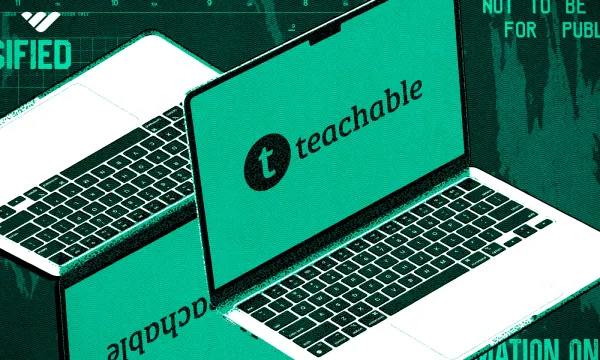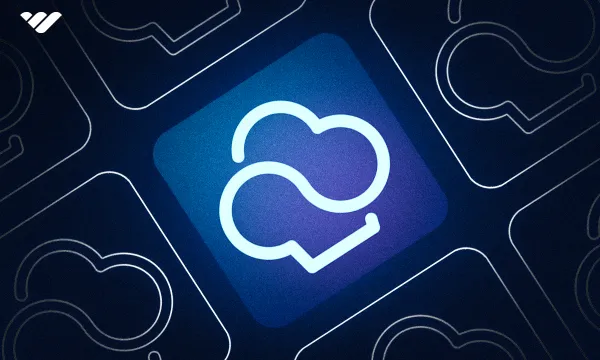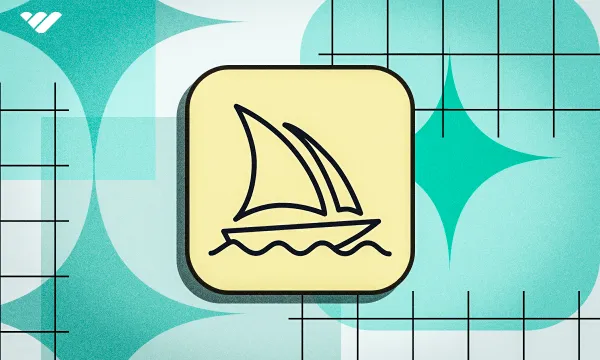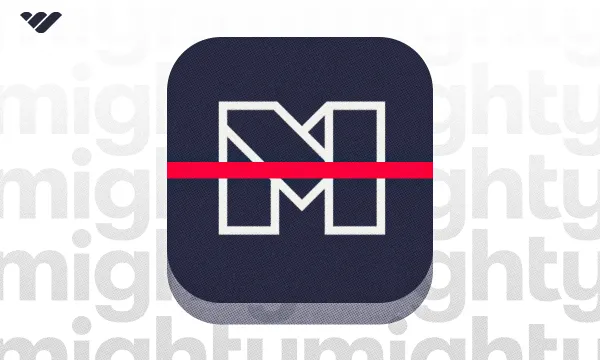Ever since the pandemic, the online learning community has started to grow at a rapid rate, with a projected 1.0B users by 2028. Coupled with the fueled growth of the creator economy, the rise of online learning platforms like Teachable was inevitable.
Content creators wanted to share their experiences, challenges and knowledge with their audience - and bundling that into an online course and selling it on Teachable was the perfect fit.
But how do you use the Teachable platform? And is Teachable the right course platform for creators?
If you're itching to take your course off the ground and make money, too, it's time to answer these questions and more. In this guide, we'll explore Teachable and review the ins and outs of this online learning platform – all with tips, examples and best practices – to help you decide where you should sell your online course.
What is Teachable?
Teachable is a no-code cloud-based learning management system where creators can build and sell their courses and other digital products.
Founded by Ankur Nagpal in 2013, what was once a team of one, Teachable soon developed into a team of 15 coding, finance, and marketing experts. By 2020, Teachable rapidly grew to over 100,000 instructors, 28,000 courses and 18 million students, helping creators earn billions of dollars to date, according to Stripe.
When I created my first online course in 2016, I chose Teachable over other alternatives like Thinkific, Udemy, or Kajabi for its uncomplicated use and user-friendly dashboard. This simplified the setup and management of my digital products without needing technical know-how.
Another reason I chose Teachable was that they handled all affiliate payouts and tax collection, which made the affiliate marketing process easier for this Canadian creator. Over the years, I've added other digital downloads like eBooks, workbooks, masterclasses and multiple courses, which helped me earn a six-figure income.
Teachable has made it possible for many to create a complete course with video, text, and extra PDFs and sell it on a Teachable school page that acts as a digital marketing tool.
Who Can Use Teachable?
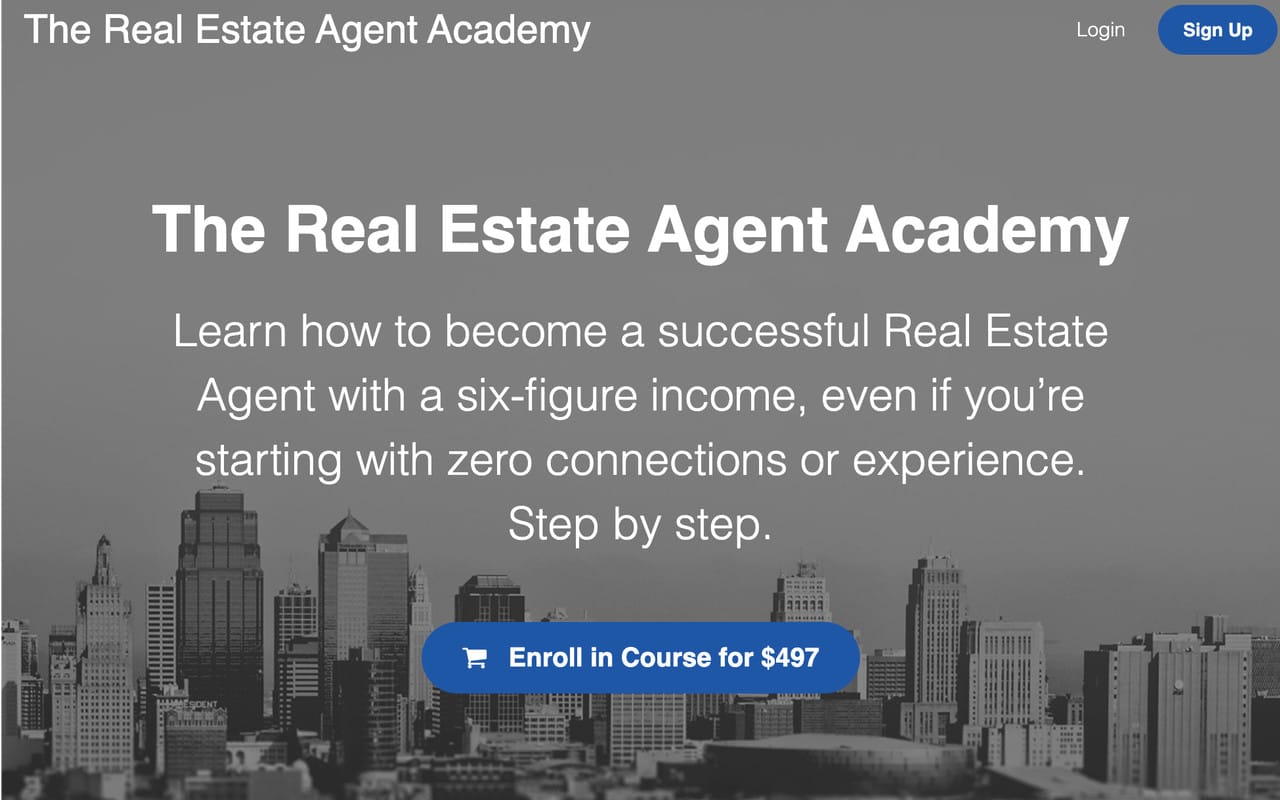
Teachable offers four payment plans, making it highly accessible to anyone wanting to monetize their knowledge. As such, it's become a popular platform for selling courses for anything from becoming a realtor to making artisan cakes, flying a drone, playing the harmonica, and other ideas spanning all industries.
It's also popular with solopreneurs like coaches, bloggers and freelancers, who want to share – and profit from – what they teach. However, not everything can be shared on Teachable.
This course platform prohibits content that violates its comprehensive guidelines, including illegal material, deceptive practices, hate speech, pornography, and unsafe activities, to ensure a safe and positive user experience. Violations may lead to removing unsafe course material or closing a user's account.
How Does Teachable Work?
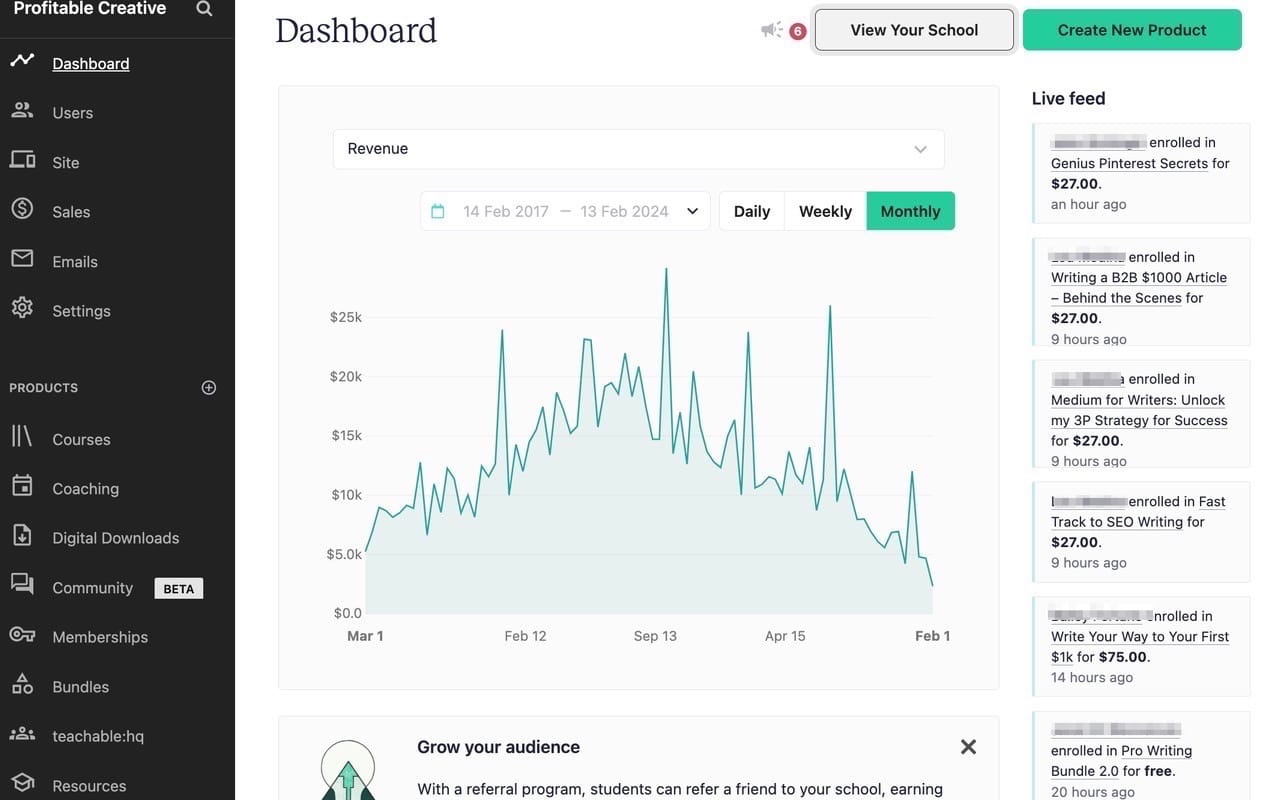
Teachable lets creators design and sell courses and coaching services all within its online course creation platform. You can securely host video, audio and text-based content on the platform with their drag-and-drop system, making it easy to get started. Creators can customize their course pages and build a professional-looking website without needing much technical skills. As a Teachable student, you can access courses with the Teachable mobile app, allowing you to learn from your mobile device anytime, anywhere.
Teachable users can handle payments, access marketing tools, and engage with students – all within the intuitive user dashboard. Plus, the platform provides analytics to track sales and student progress, making it a comprehensive tool for content creators.
Getting Started & Selling on Teachable
When creating a course for the first time, you want the process to be as smooth as possible. Well, Teachable makes that process easy within the first step of creating an account.
Use the Teachable login with your business information and choose a payment plan that works for you.
They offer a free tier, which allows you to create one course, but you can only have ten students in your school. This might seem like a lot of students, but once you publish your digital product, you could have a flood of people dying to buy your course. While that's a good thing, it's not when you're on the free plan.
Once you reach that cap for students or create more courses, you have to move on to the Basic Plan ($39/month), Pro Plan ($119/month), or Pro+ Plan ($199/month). The Pro Plan is the most popular, as you can create up to 50 courses, coaching, or digital downloads.
Teachable Course Builder & AI Assistant
Once you create an account, you must also name your Teachable school. This becomes your Teachable URL. Mine is Profitable Creative. You can change the name of your school later, so there's no need to spend much time on this.
Next, Teachable asks questions about your online business to help fine-tune your experience. You can choose between starting a course, digital download, coaching or community. If you can't decide, you can just skip this step altogether.
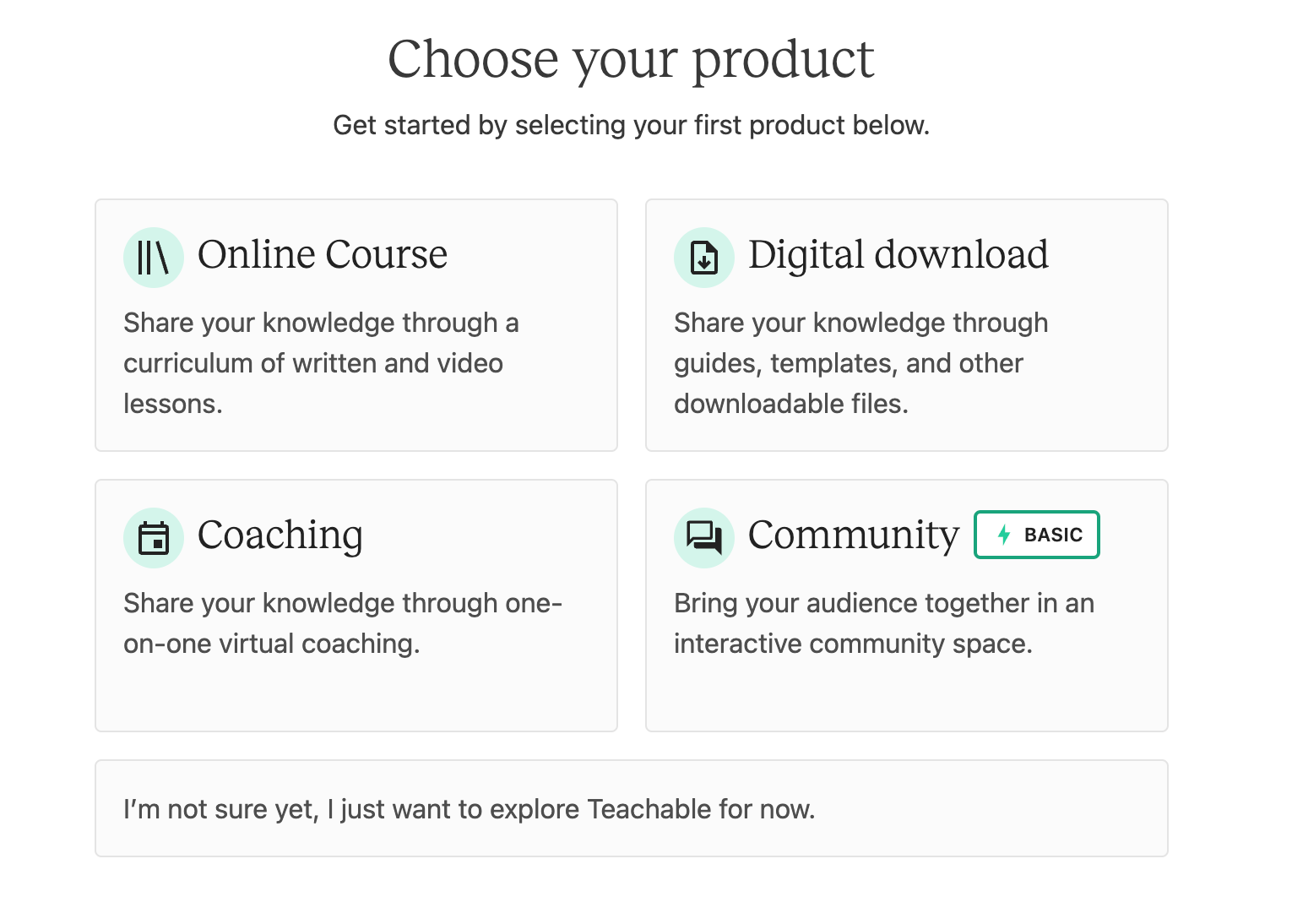
You'll be taken to the backend of your Teachable school, where you can start creating your first online course. Now, if you can't think of what to create, Teachable has enabled AI to assist you in this process.
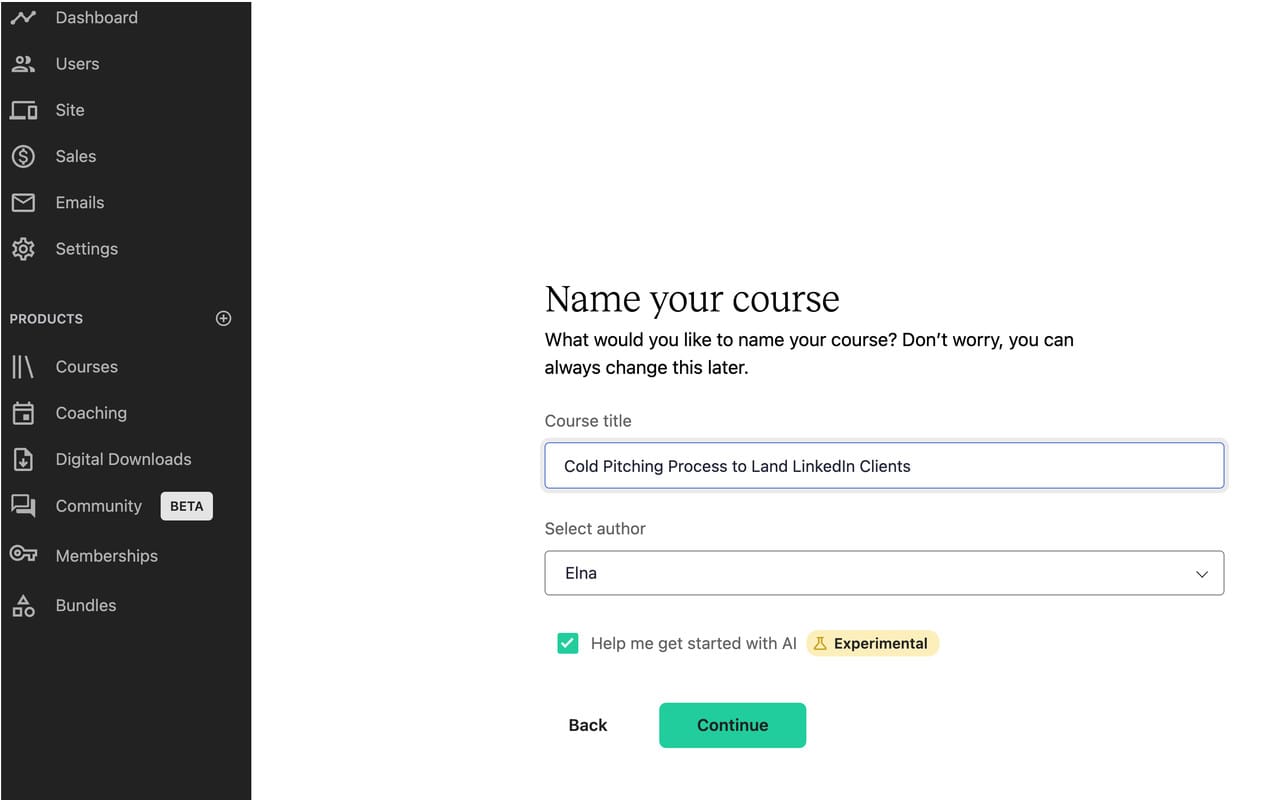
To start the Teachable AI assistant, you have to give your course a title. Next, share what the course is about and what you want to teach your students. With that information, Teachable AI will create a course outline with modules and lessons.
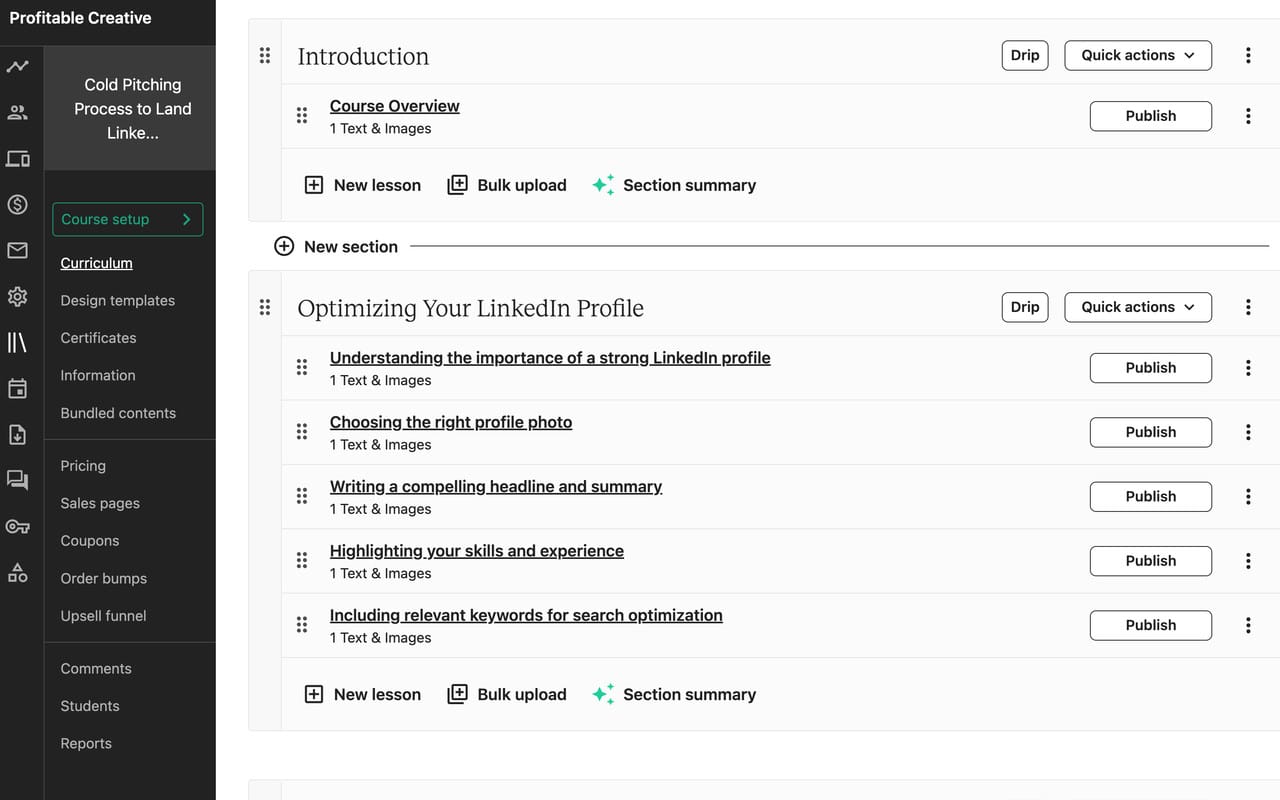
Each lesson has an AI text writeup, and you can edit the content material or create a video from the lesson.
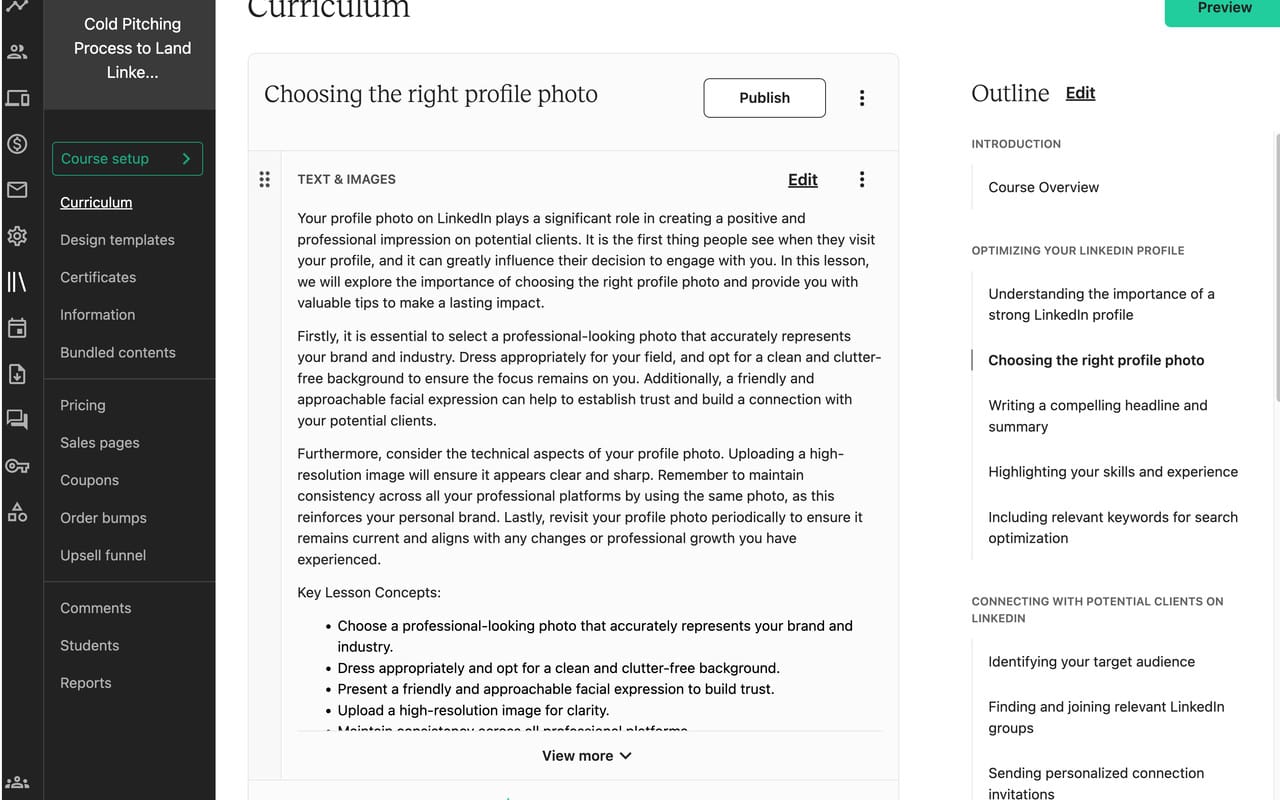
Teachable's AI assistant can seriously speed up the process of course creation and it's easy to set up too! But, if you forgo using AI, you can create an online course one module and lesson at a time – the traditional method. When ready, simply upload your video and write a lesson underneath to make an educational session for students.
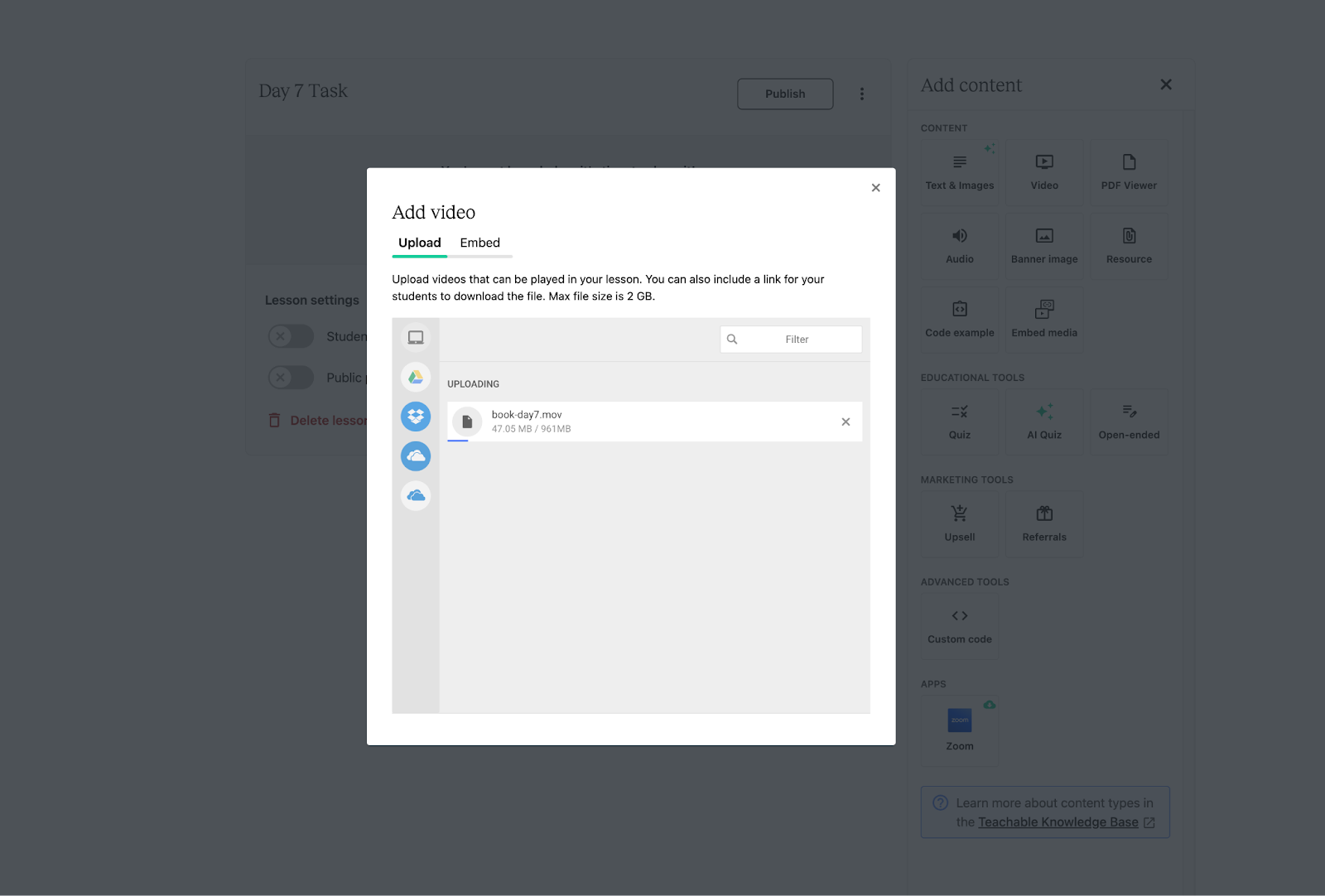
Once the course and supplemental guides are uploaded, it's time to create the sales page, any upsells or order bumps, and the pricing page.
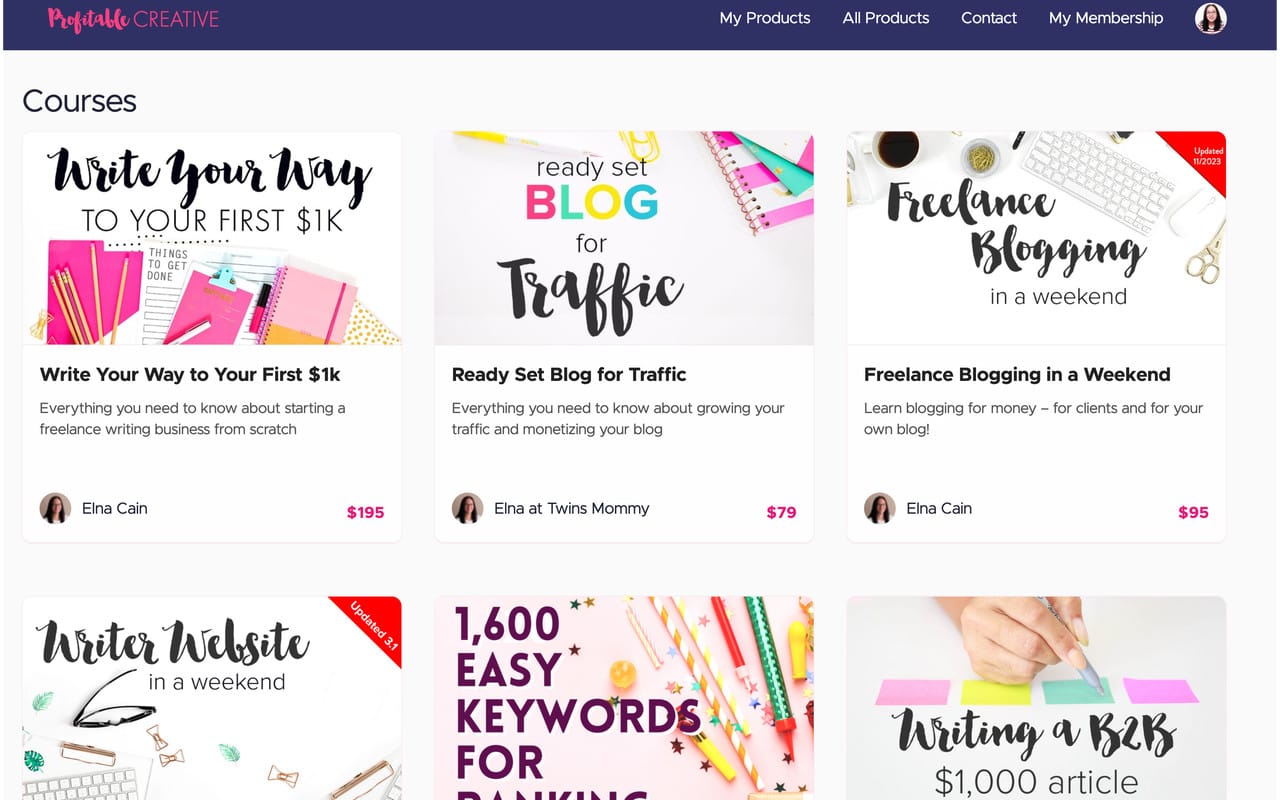
Teachable Coaching Builder
If you're a coach, Teachable has a coaching option to help you set up milestones to keep track of coaching progress, keep notes, and send messages between you and your client. This helps keep everything in one place rather than using multiple apps and tools.
Once you state the type of coaching that you will offer on Teachable, you then must decide the intake process.
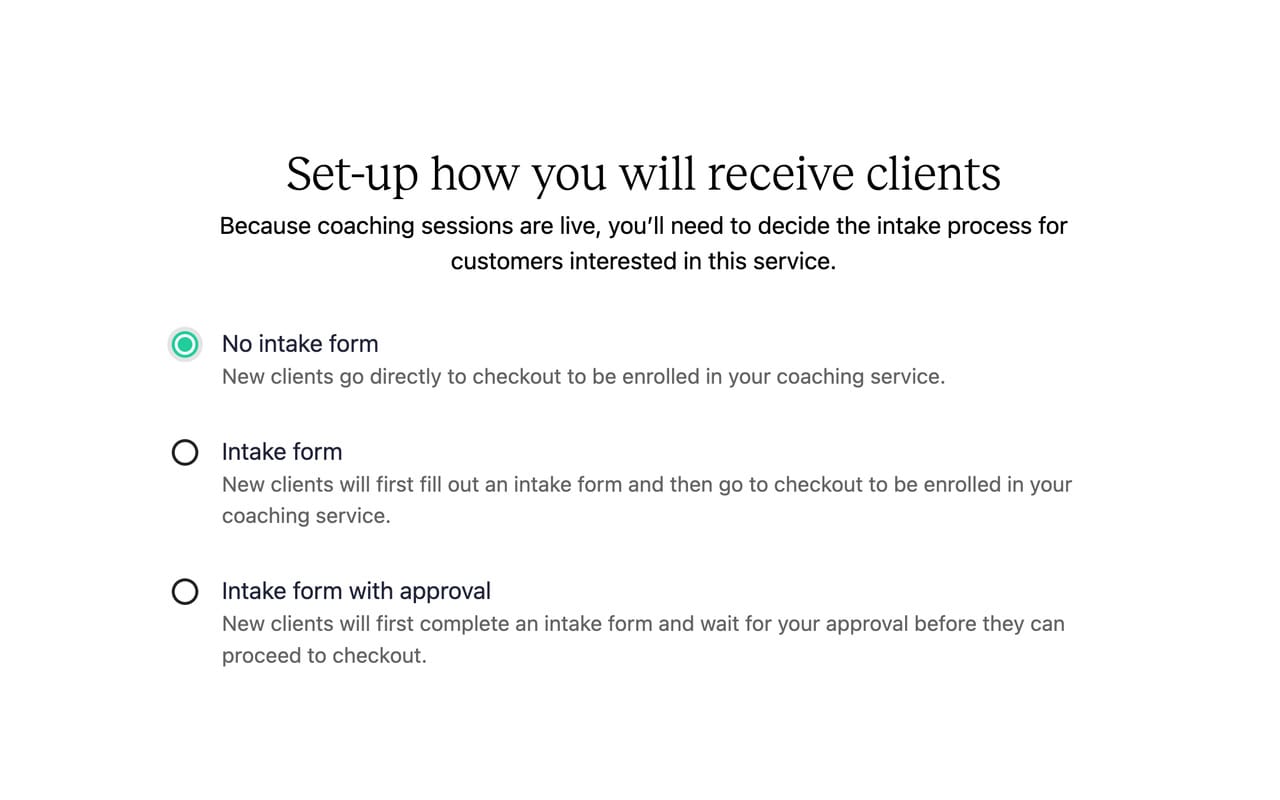
If you choose an intake form, you can customize it later. From there, decide the payment process: one-time purchase, payment plan, subscription fee, or not sure. If you choose a purchase option, Teachable allows you to cap the number of clients enrolling, which helps you manage your time if you can't fulfill all the people wanting coaching services. Decide on the starting date: fixed or ongoing enrollment.
Next, customize your first milestone by welcoming your coaching clients and sharing what the program entails. You can also add a link to your Calendly to schedule a coaching call with your clients. Teachable has native support for Calendly, making it a simple integration with your tools.
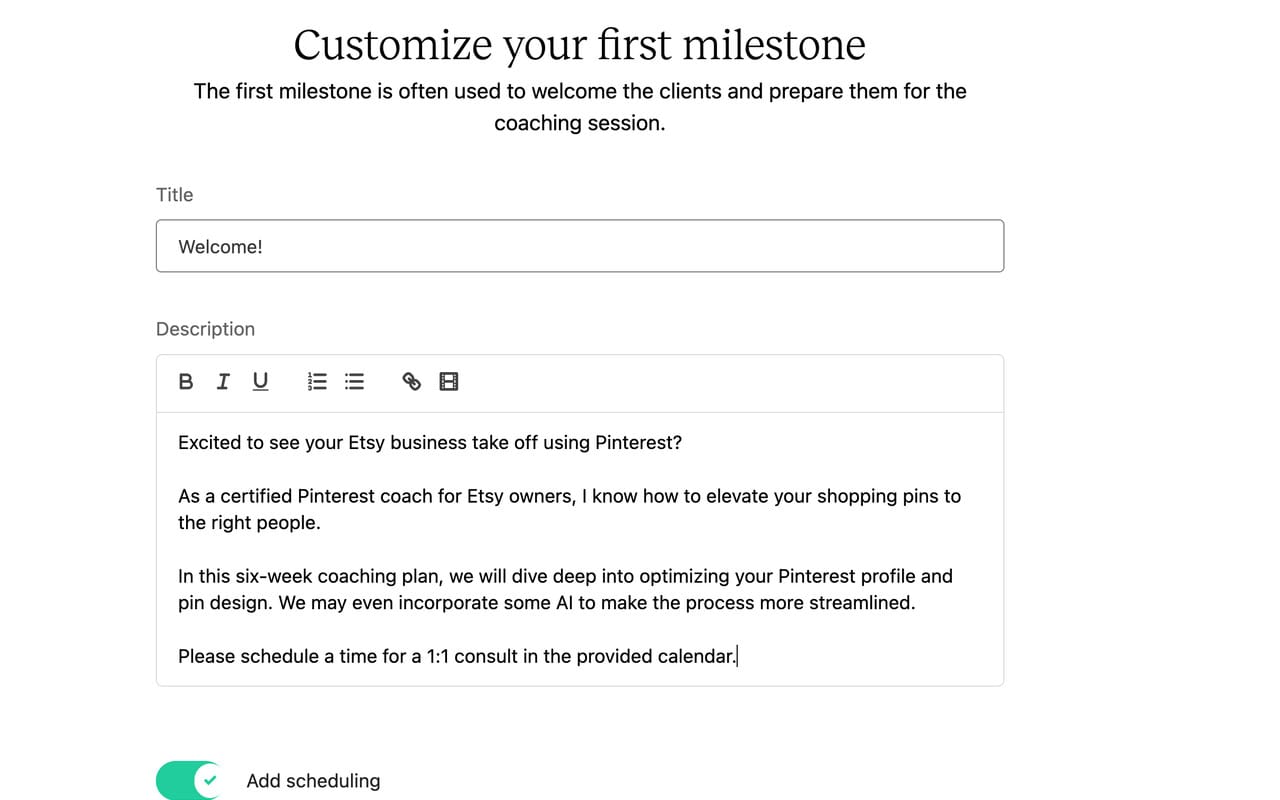
The next part is designing your sales page and intake form. Customize your intake flow by assigning whether you want approval when people fill out your form and what each section says.
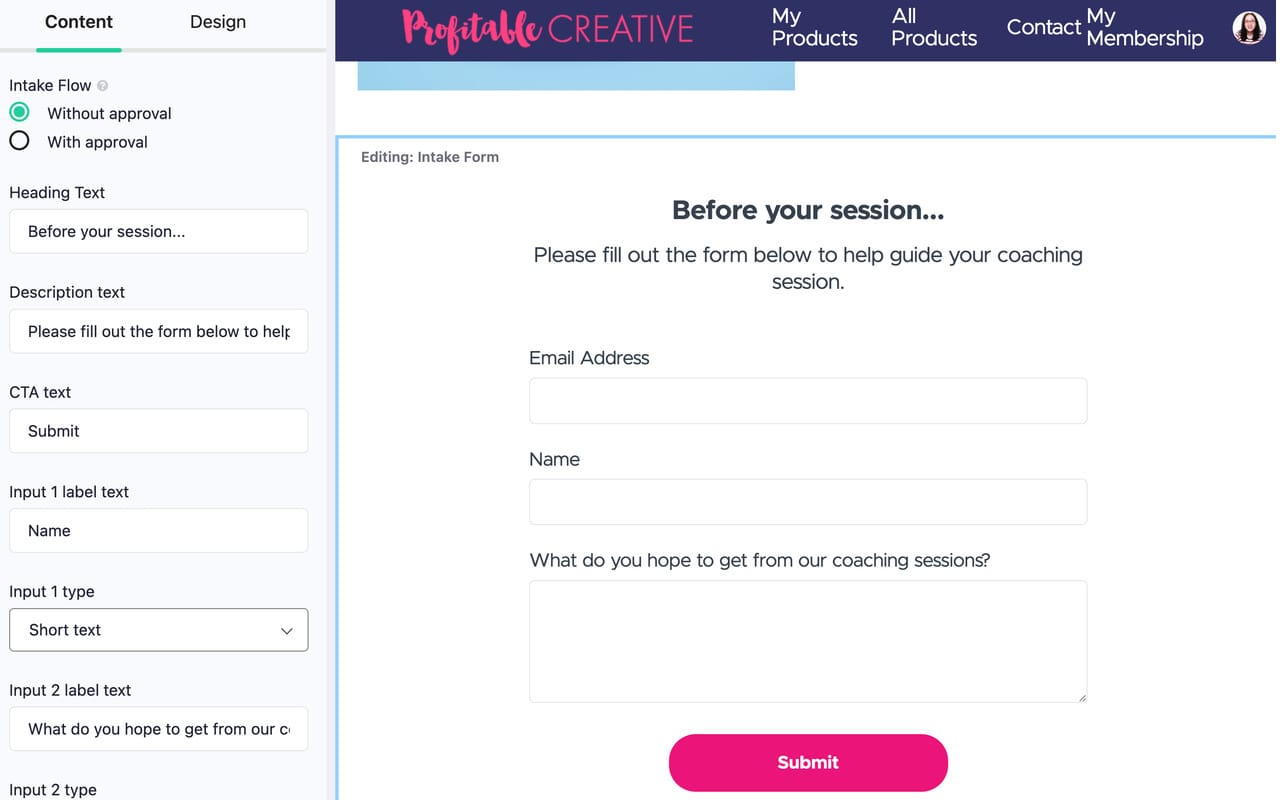
Once all the pages are set, you can start offering coaching services!
Teachable Community Builder
Now, if you want to foster a deeper connection with your students, you can start a community on Teachable. Unlike Discord, which is a general communication platform, Teachable Communities is specifically designed for educational purposes. It integrates community interaction directly with the learning content, providing a seamless experience where students can engage with each other and the course material in one place.
To enable a new community, once you click "create a community," Teachable takes a few minutes to create one and will email you the link when it's finished.
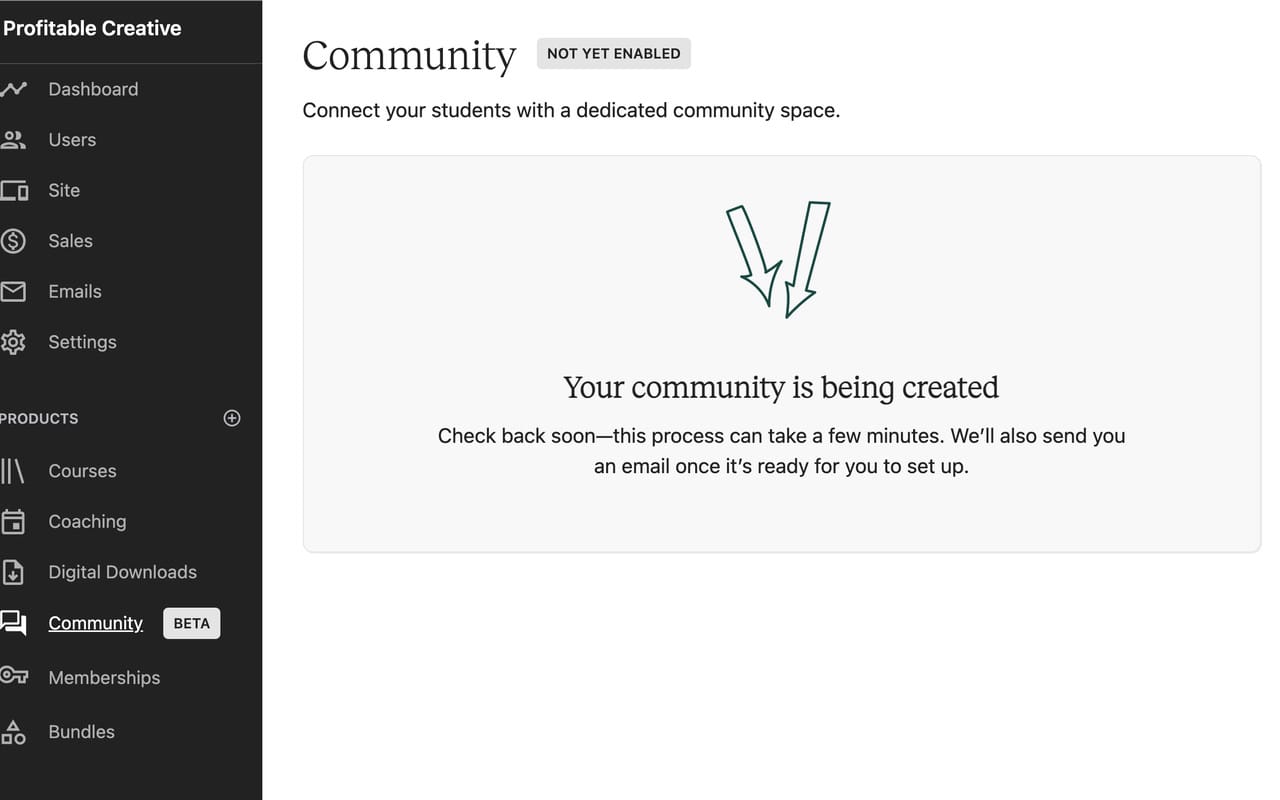
Once you receive the email confirmation and click over, you can share a link to your community and edit access to who can join. You can change the name and choose what access they have and what permissions are allowed.
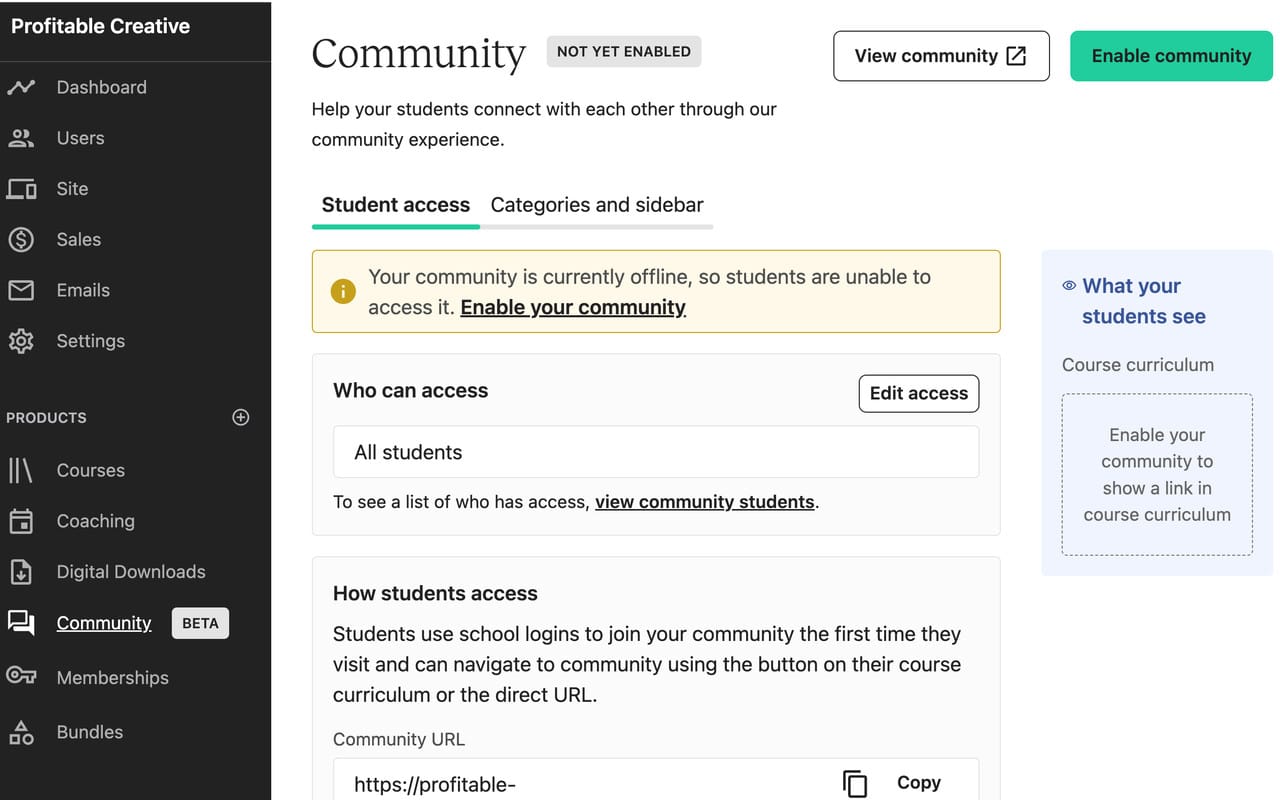
Next, you can include all your students, or select students enrolled in a specific course.
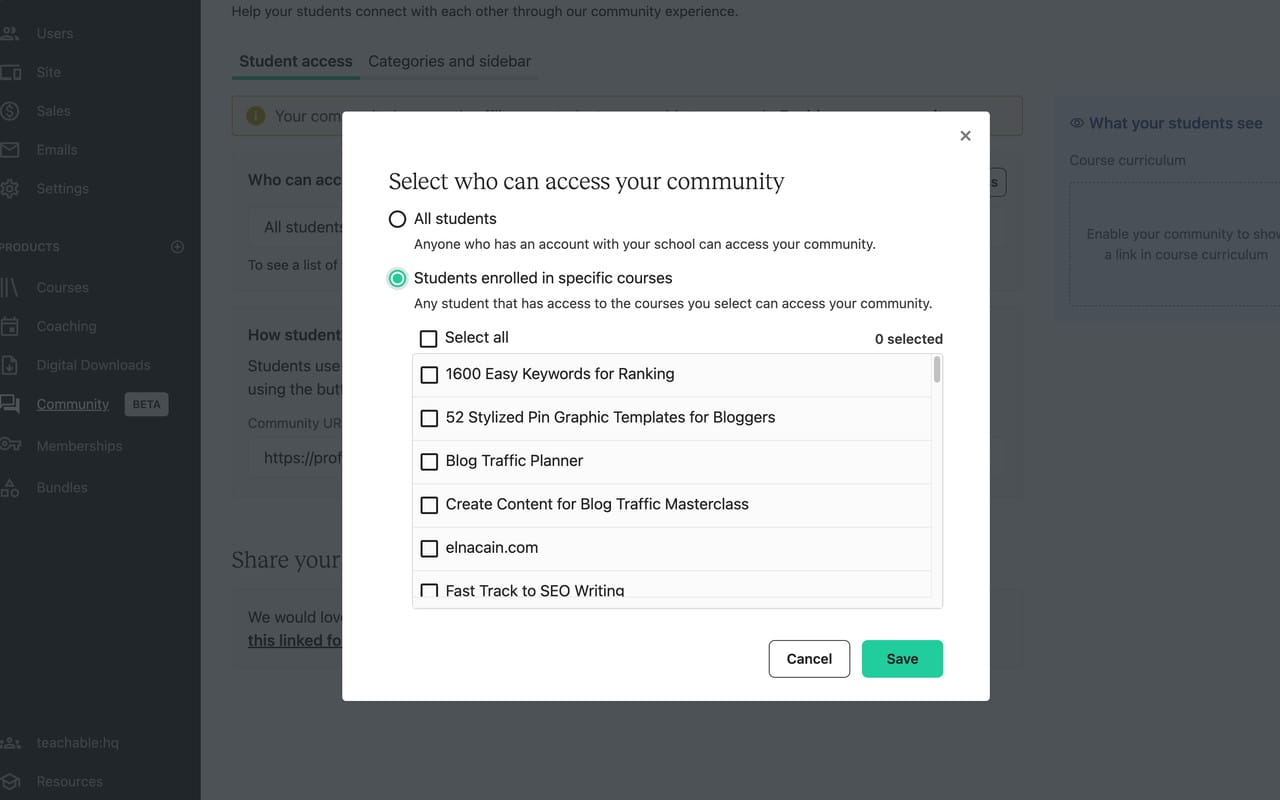
Under 'Categories and Sidebar,' you can organize and control access to different parts of your Teachable community.
In Categories, you can add new categories or edit the existing ones to make them more relevant to what you want your students to learn and engage with.
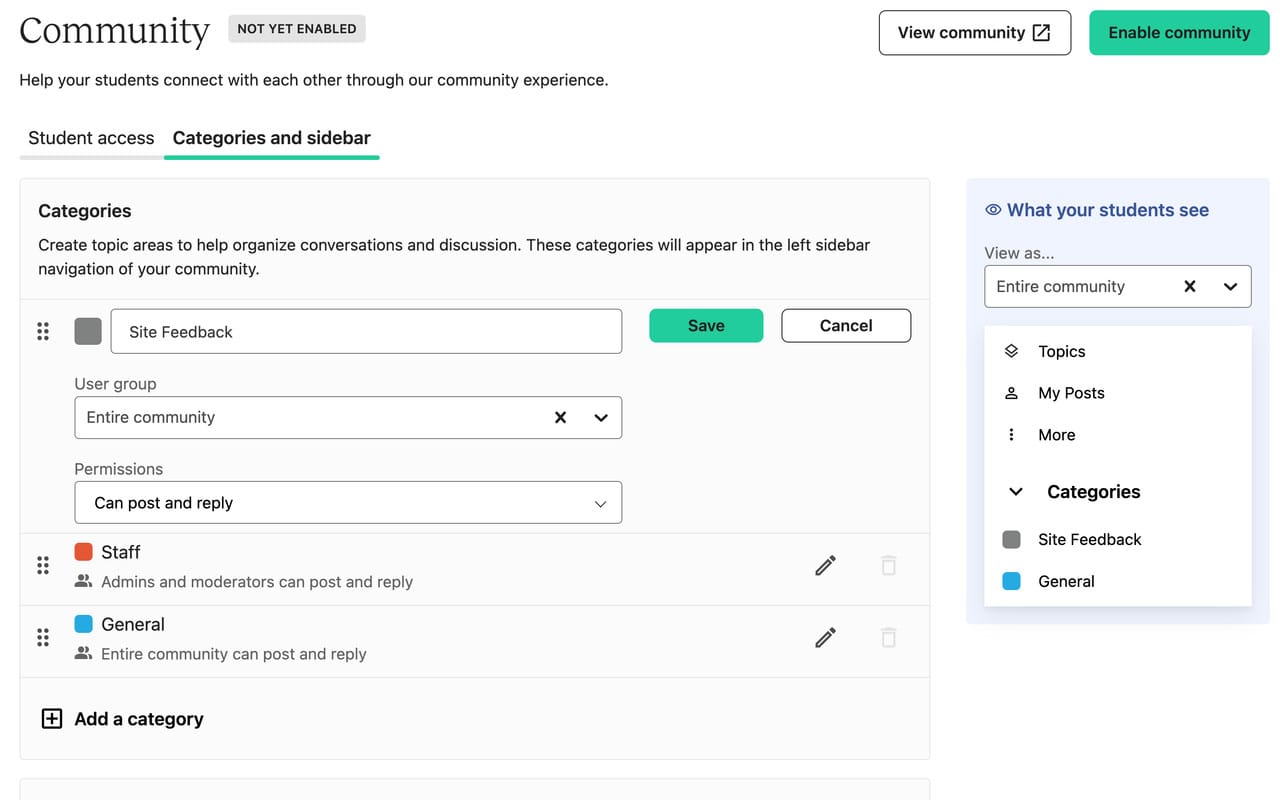
Once those are set, you can view your community to see the layout and categories listed.
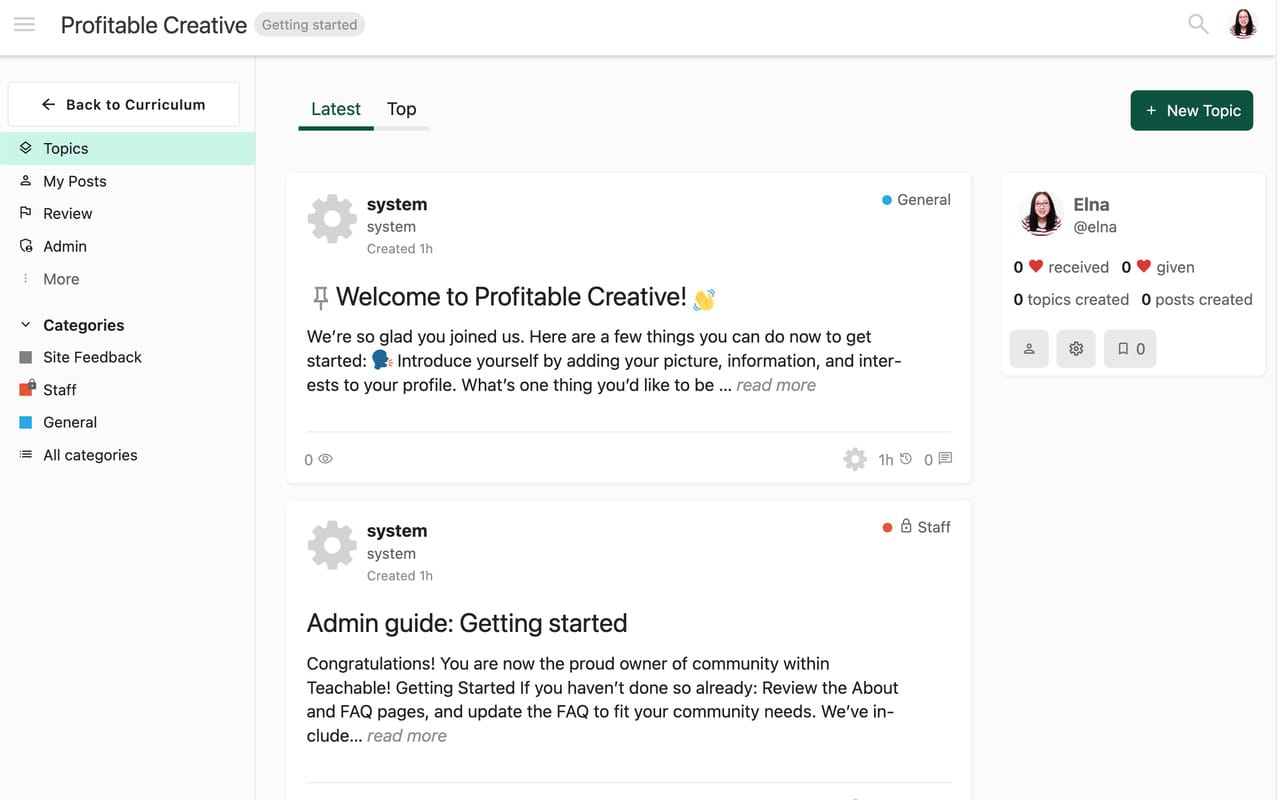
If you are happy with the structure of your community, make sure to enable it (in the previous window) so that students can start engaging in the conversations. If you connect your community with a course, you'll see a new icon on the sidebar for communities.
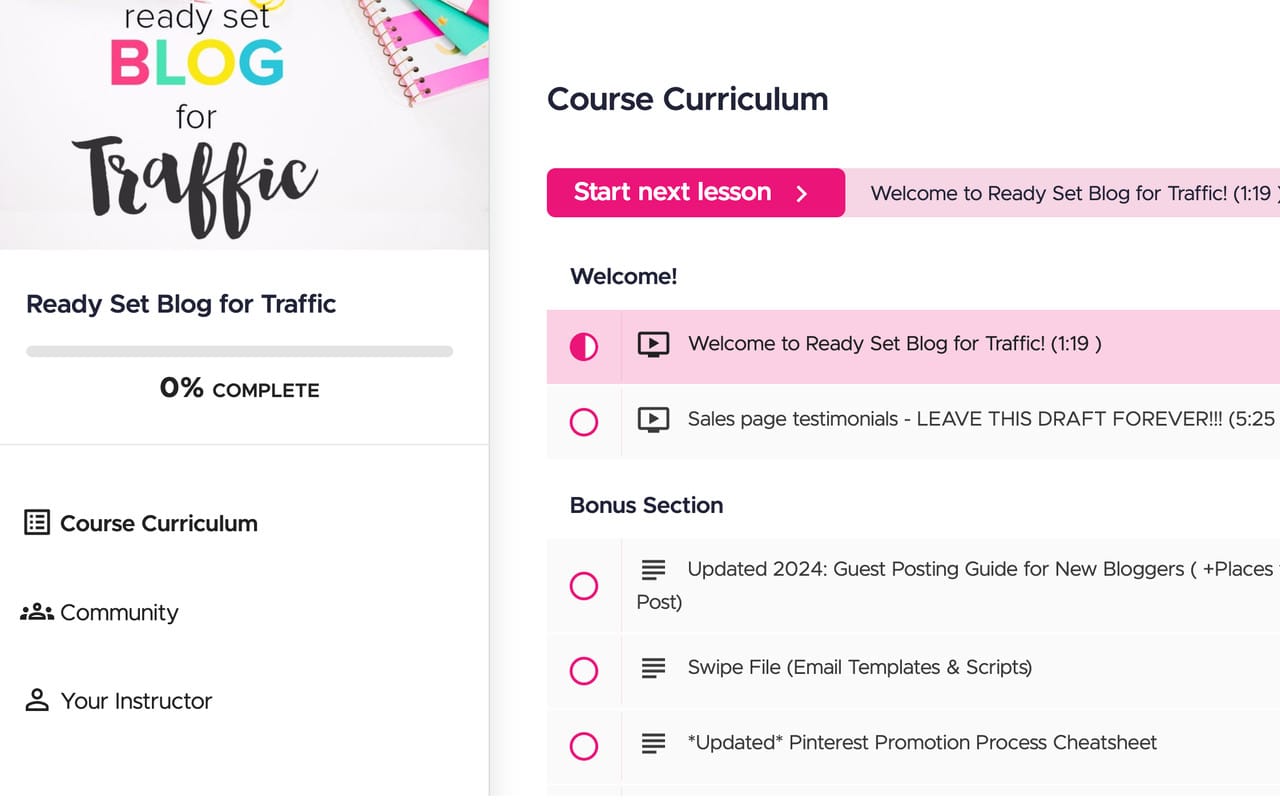
Teachable Membership Builder
For the more savvy content creator, you can start a Teachable membership to scale your business. Students pay a monthly subscription fee to access a creator's content library. While a user needs to provide fresh content regularly, the lifetime value of each student who signs up increases by 43%, according to Teachable. So, it's a worthwhile option for creators wanting to scale their business.
To start a membership, make sure to create and publish all the pieces of content like courses, guides, video and more before you build it in Teachable. You'll make a membership from your existing Teachable courses. Begin by naming a tier in your membership and adding products to that tier.
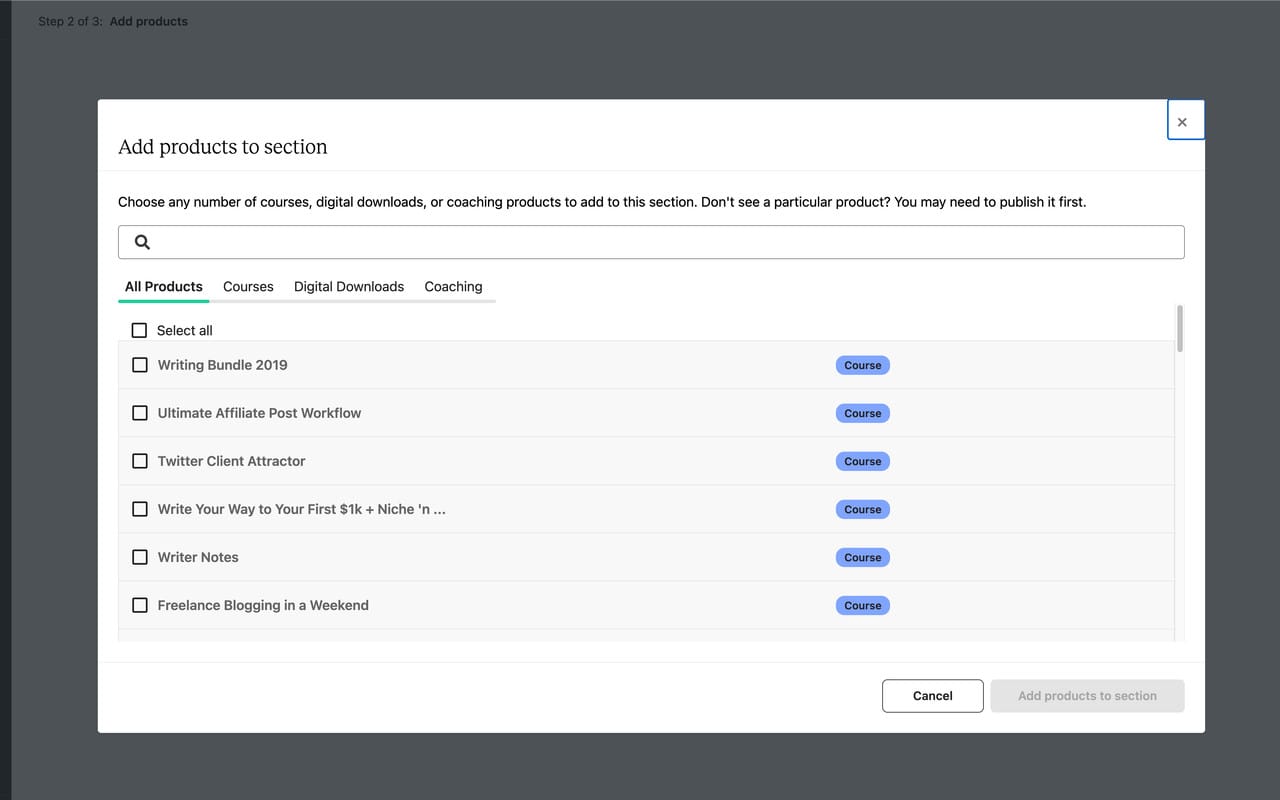
Next, set your prices for your tiers. You can then customize each tier or manage your membership.
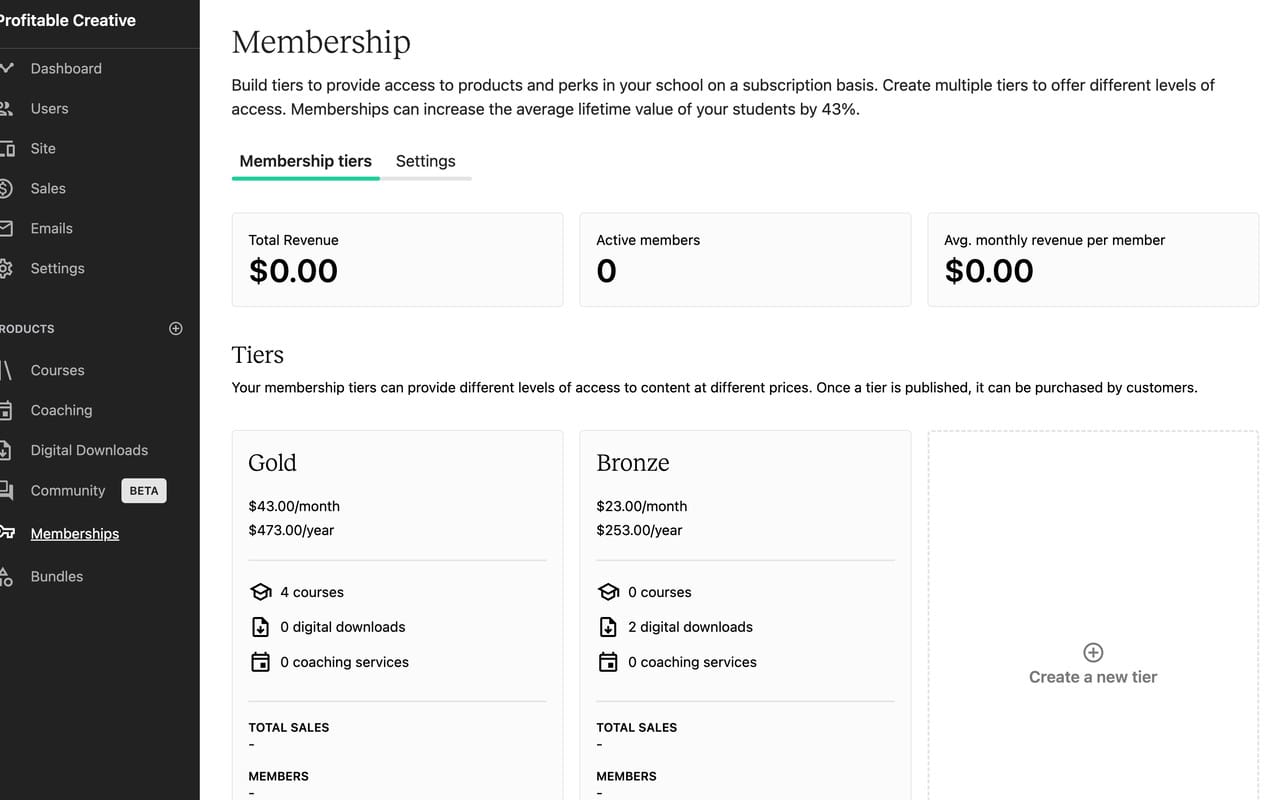
Teachable allows users (even in the Basic plan) to email their students on the platform. But, if you already do your own email marketing, Teachable integrates with email service providers like Convertkit. So, when a student signs up for your membership, they'll already be added to your Convertkit account and tagged accordingly.
Teachable Digital Downloads Builder
While courses, memberships and communities seem like awesome ways to make money, if you don't want to deal with having to update dozens of lessons in a course or having to come up with new content ideas each month for your membership – or having to show up to boost community engagement – you don't have to.
If all you want is to sell an eBook, audiobook or even art, you can do so with Teachable. Add the name and category to your digital download.
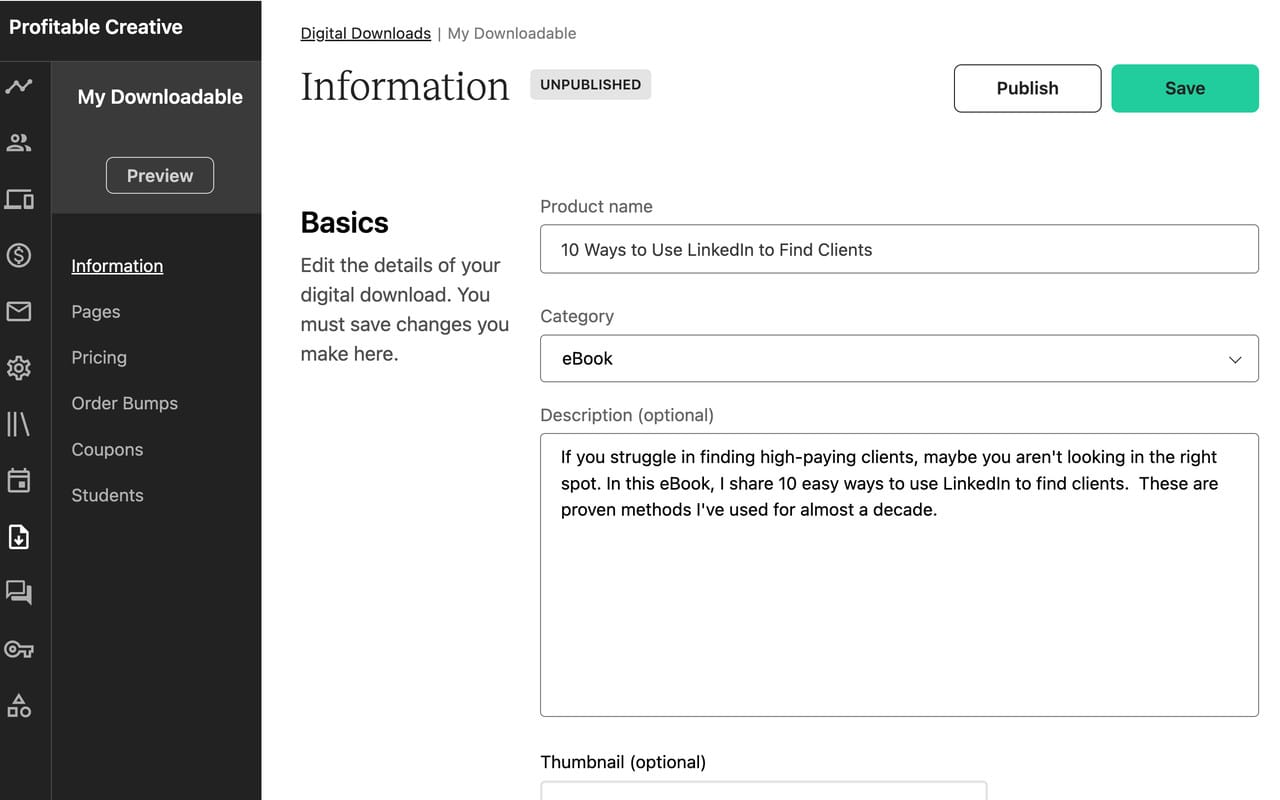
From there, you can use the sidebar to create the sales and pricing page and any order bumps or coupons you want to enable.
Teachable Pros and Cons
So, is Teachable the best online course platform out there? What about when comparing it to competitors like Thinkific or Kajabi?
How will Teachable hold up? Let's look at the features and challenges of using Teachable.
Teachable Pros
Teachable prides themselves on listening to the creator community and building more features with them in mind. From more customization options to integration capability and support channels to robust marketing and sales features, Teachable has heard what creators need the most.
1. Customization Options
Teachable has a solid range of customization options that won't overwhelm content creators.
There are three course design templates to choose from – Teachable Classic (only available to schools created before June 2022), Simple and Colossal – to help you set your school's overall look and feel to match your brand.

You can also modify your school theme to tweak the visual aspects of your site, such as colors, fonts, and layout. And, for a more unique look and feel, you can add HTML/JavaScript.
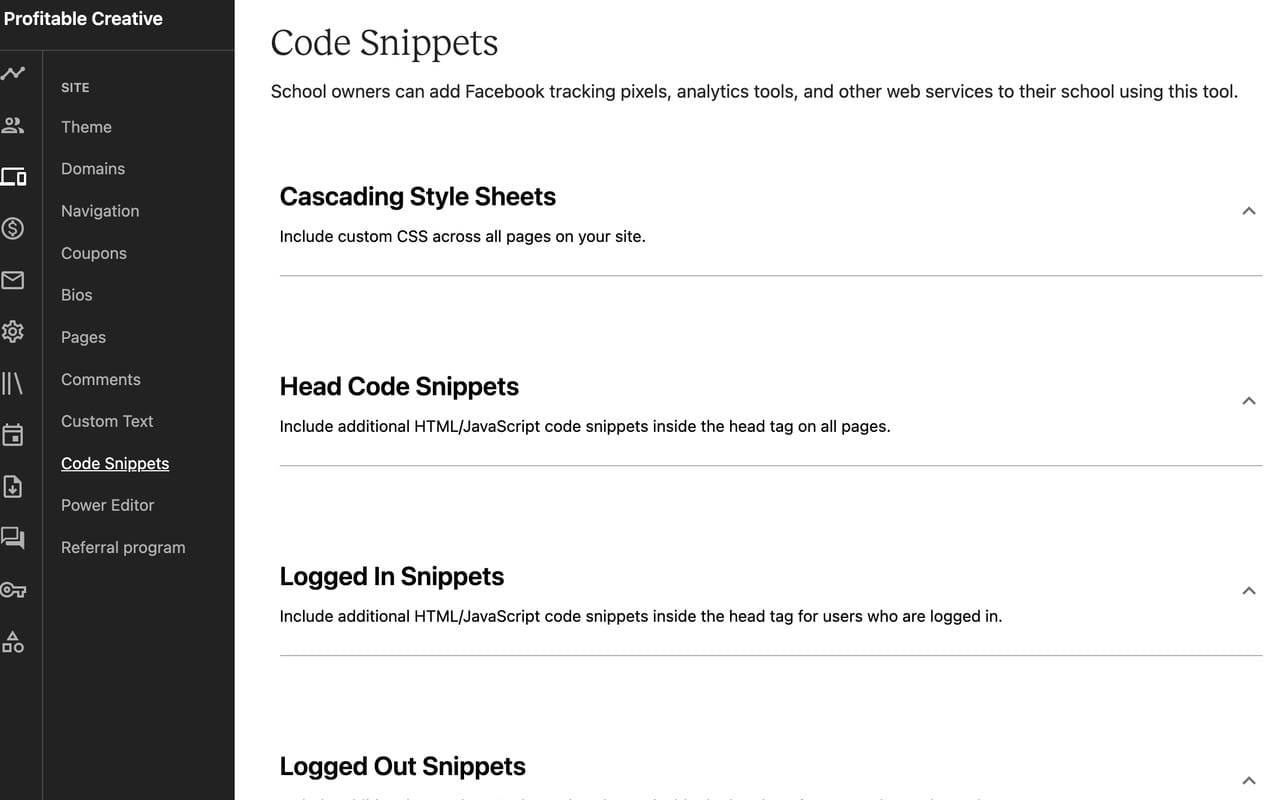
This reflects your brand identity and provides a tailored learning experience for your students. Here is what my course page looks like for students.
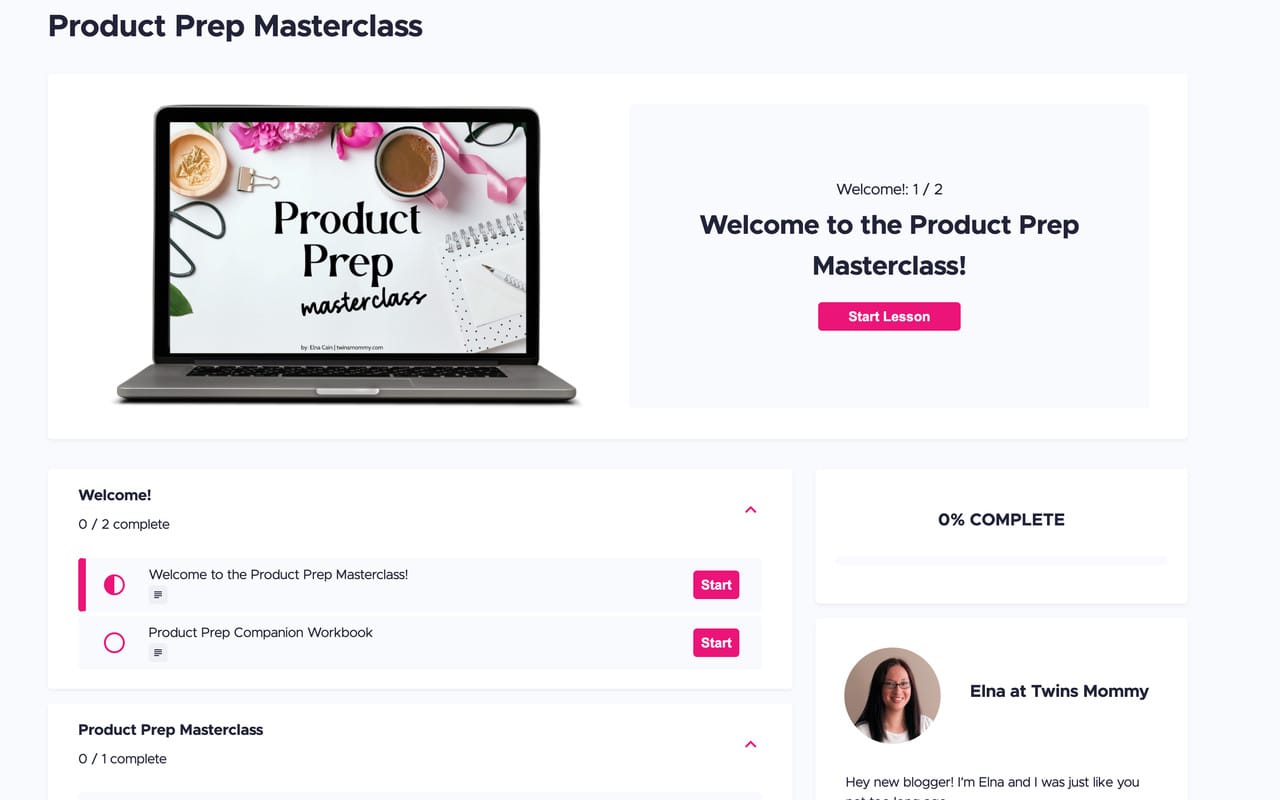
But, if you want your Teachable school to be as cohesive as possible with your brand, Teachable integrates with site design tools like DropInBlog and Unsplash with a click of a button.
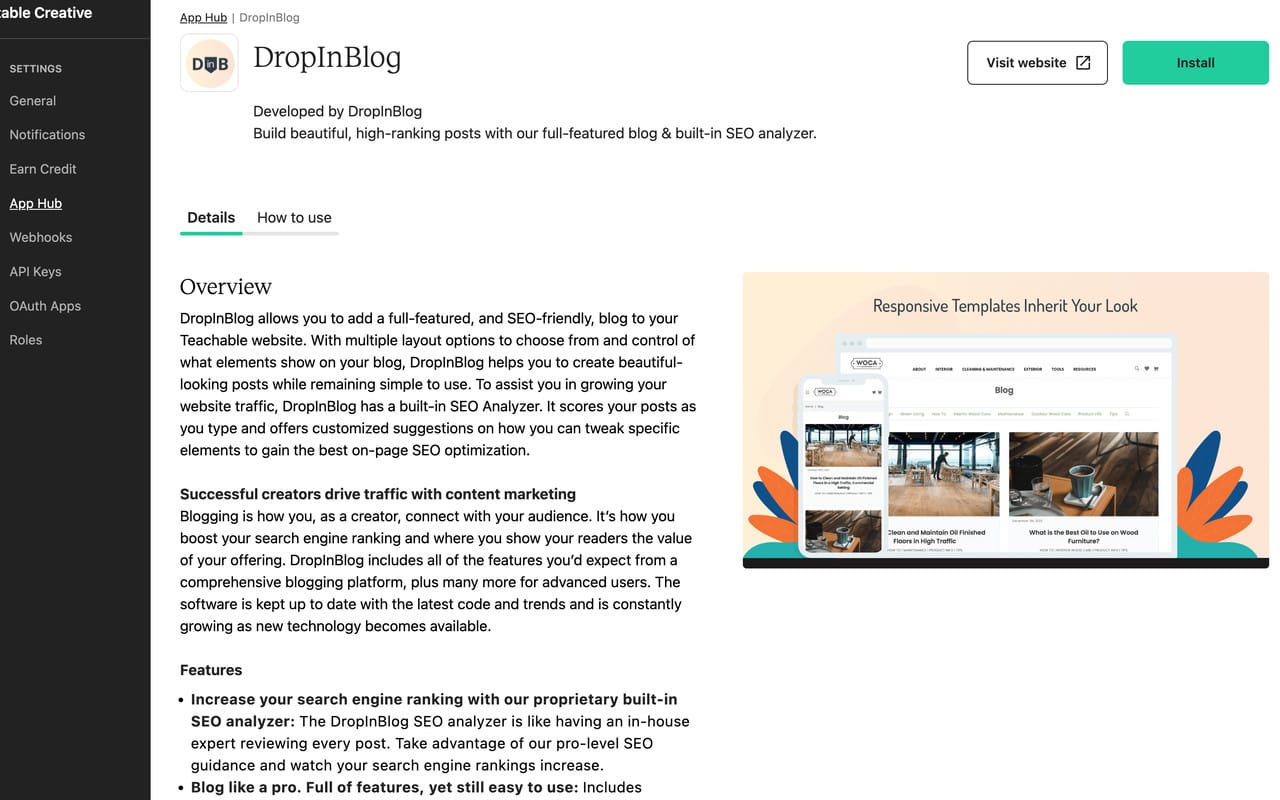
Teachable shines when it comes to actually starting a course. It's easy to create sections – just click on the option you want – drip-out lessons and add quizzes or audio files, which helps enhance your student's learning experience.
2. Integrations
There are several integration options available on the Teachable website.
Email marketing platforms like MailChimp, Convertkit, and ActiveCampaign allow course creators a simplified way to communicate and nurture their leads.
Similarly, Teachable supports Stripe and PayPal for smooth and secure transactions. This means that you can opt for automatic enrollment upon purchase, making the user experience more streamlined and hassle-free.
You can also host live training or webinars by using third-party integrations like Zoom, Twitch.tv, LiveStream, Youtube, or Adobe Connect for a more immersive experience.
Also, Google Analytics and Meta Pixel provide insights into your website's performance and student behavior. Use the data to help understand students interacting with your content, informing your marketing and content creation process.
For tracking pixels, make sure you comply with privacy regulations like GDPR, and consult a legal professional if needed. And, if you've added a pixel using code snippets, remove it before using a new integration to reflect accurate data collection.
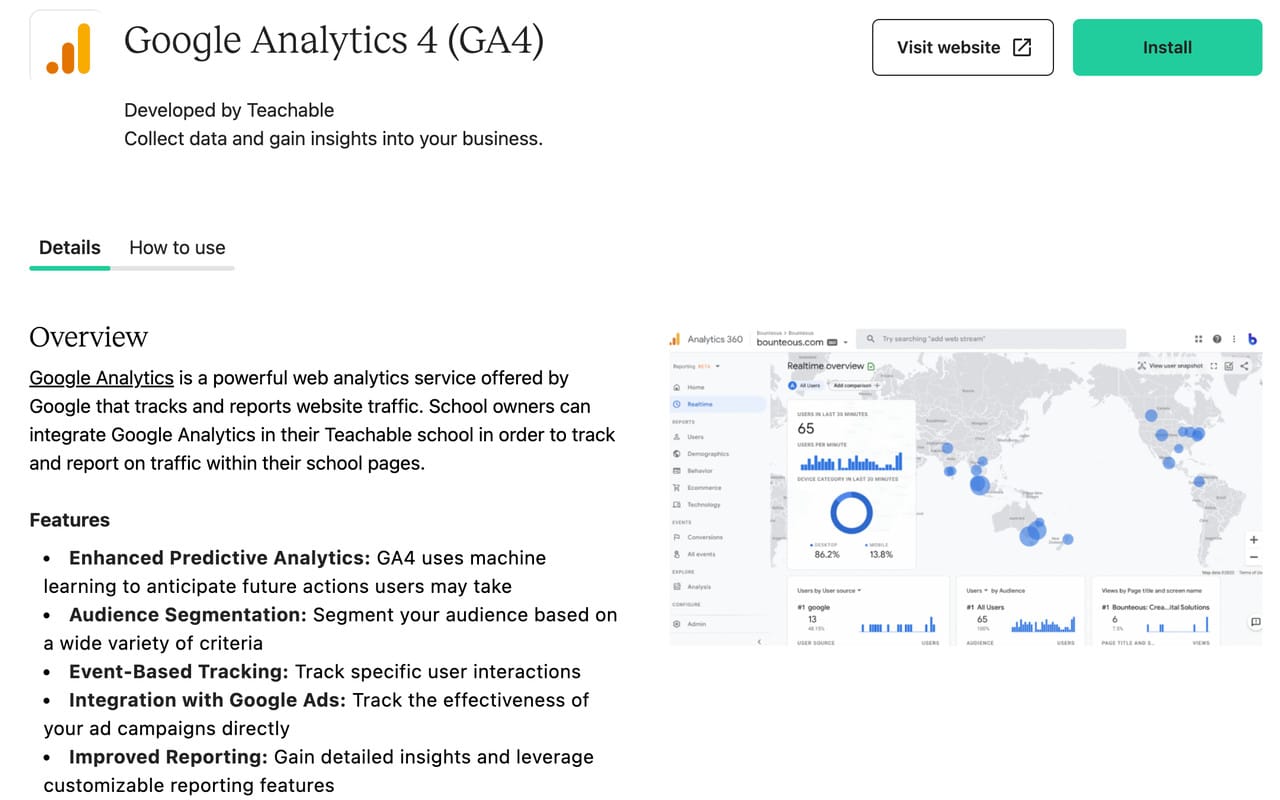
When integrating third-party tools with Teachable, know that Teachable's customer support doesn't offer maintenance or troubleshooting. Changes made within these tools may also affect their functionality or compatibility with Teachable.
Finally, Teachable integrates with Zapier for marketing automation and connectivity with over 6,000 other apps and services, allowing customized workflows to save time and enhance efficiency.
3. Support Channels
There are a range of support channels to help course creators. For starters, the Teachable blog and newsletter has a wealth of helpful advice covering marketing topics, business advice, productivity tips and more.
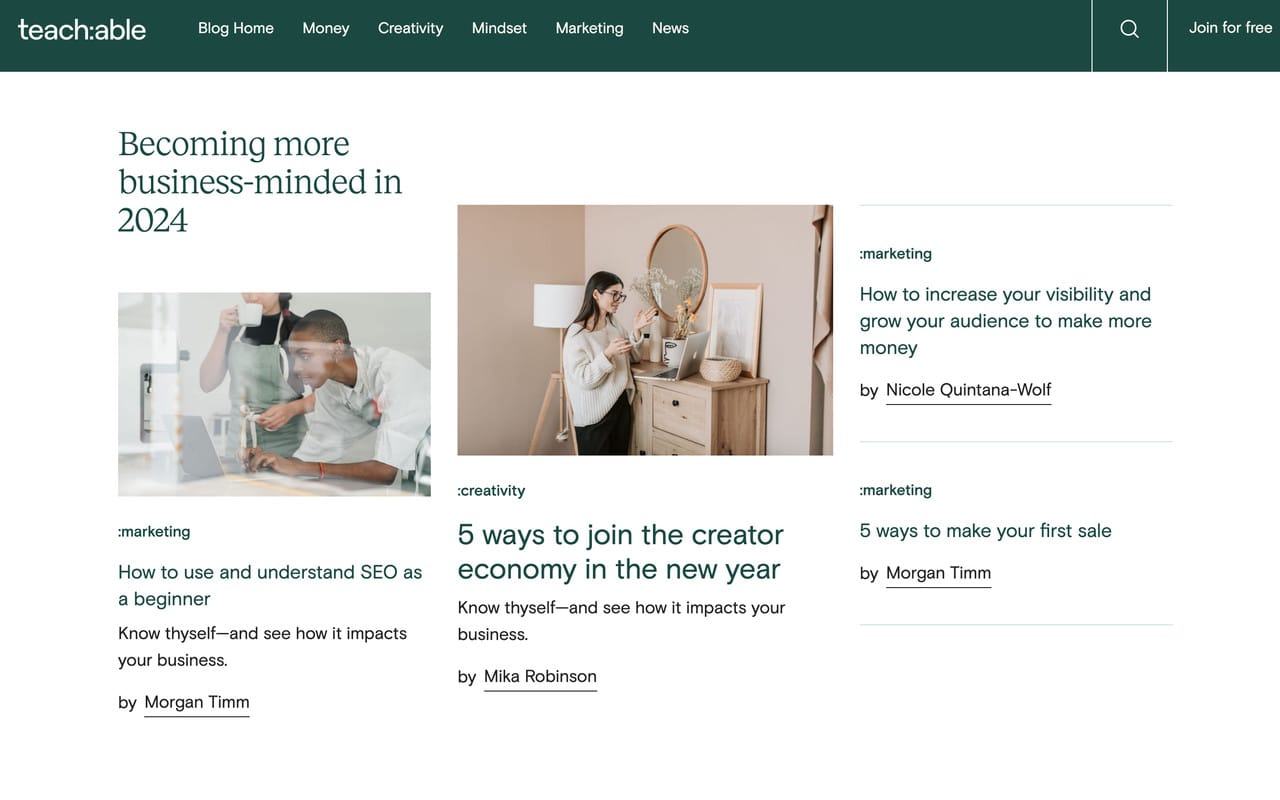
Teachable offers a general help center called 'Knowledge Base' for all payment plan options. You can ask a question or click on the many options like billings & payments, user management, student guides and more.
There is also the Launch Accelerator Challenge that paid users can access in the backend of their Teachable School. This is a 30-day course creation challenge with the help of trained Teachable experts.
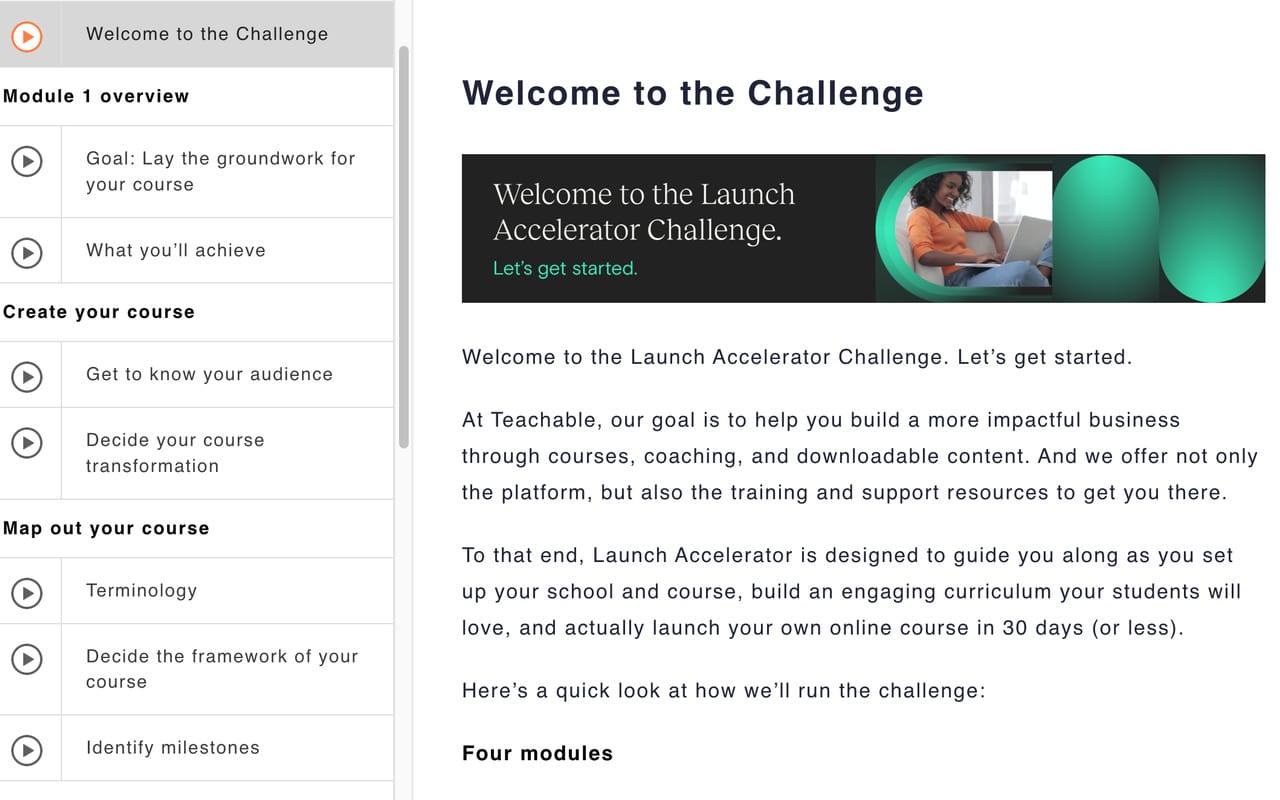
And if you want to bounce off ideas, network, and connect with other Teachable course creators, you can use the Teachable:hq community, which is available for paid plan members.

Email support varies whether you're on the Free Plan (limited to M-F 8:00a to 8:00p EST every day) or on the paid plans (unlimited email support 8:00a to 8:00p EST every day). And, if you are on a paid plan and want Live Chat support, you can access this Monday - Friday 10a - 5p EST.
On top of the support offered, Teachable also makes it a safe platform. Teachable efficiently handles fraud monitoring and offers chargeback support, giving users peace of mind knowing their financial transactions are secure.
4. Marketing and Sales
Teachable offers a whole suite of marketing and sales features to help creators reach more students and generate more revenue.
A useful feature for students is the subscription payment model. If your course price is outside a person's budget, paying monthly is possible. With the recession and inflation creeping up, I'm finding that the payment option is a popular choice for many of my students.
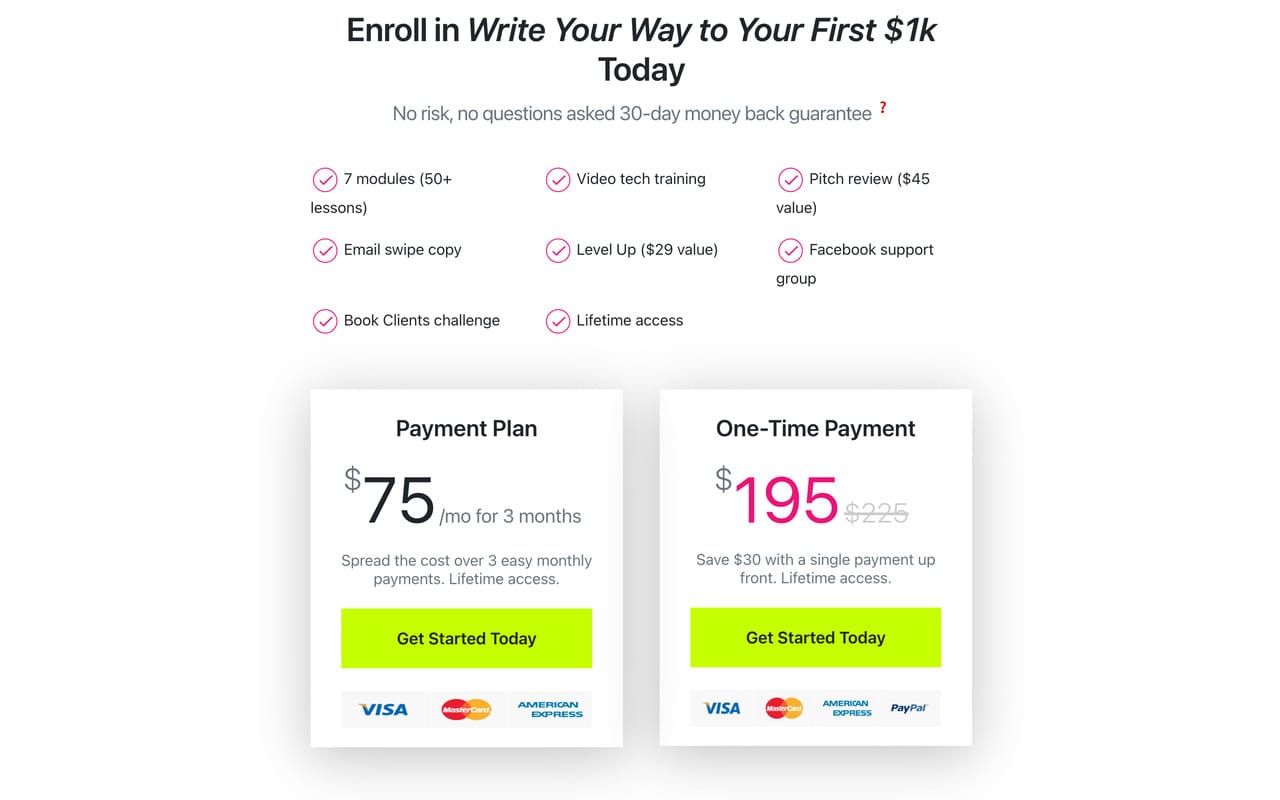
Another marketing and sales feature that's invaluable for creators is the option to offer free content. You can grow your email list with lead magnets that funnel people into your Teachable school.
For example, I offer my free email course on Teachable and Convertkit.
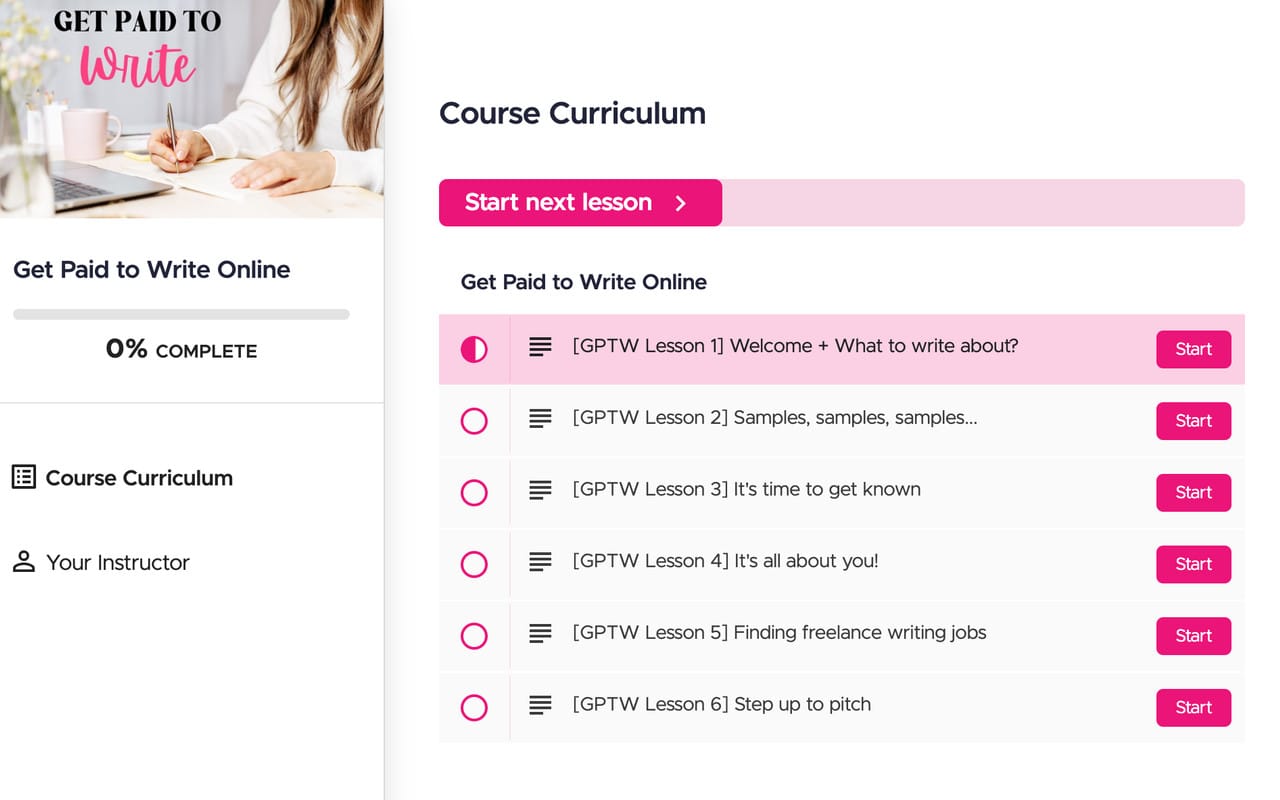
They also offer an affiliate program so that other creators can promote your courses and earn commissions for each sale they refer. This helps widen the pool of potential students when you get others to share your course.
And, if you want to scale your income, Teachable offers:
- Order bumps
- Coupons
- Upsells
- Drip courses
- Abandoned cart
Here is what an order bump looks like on your course order form page.
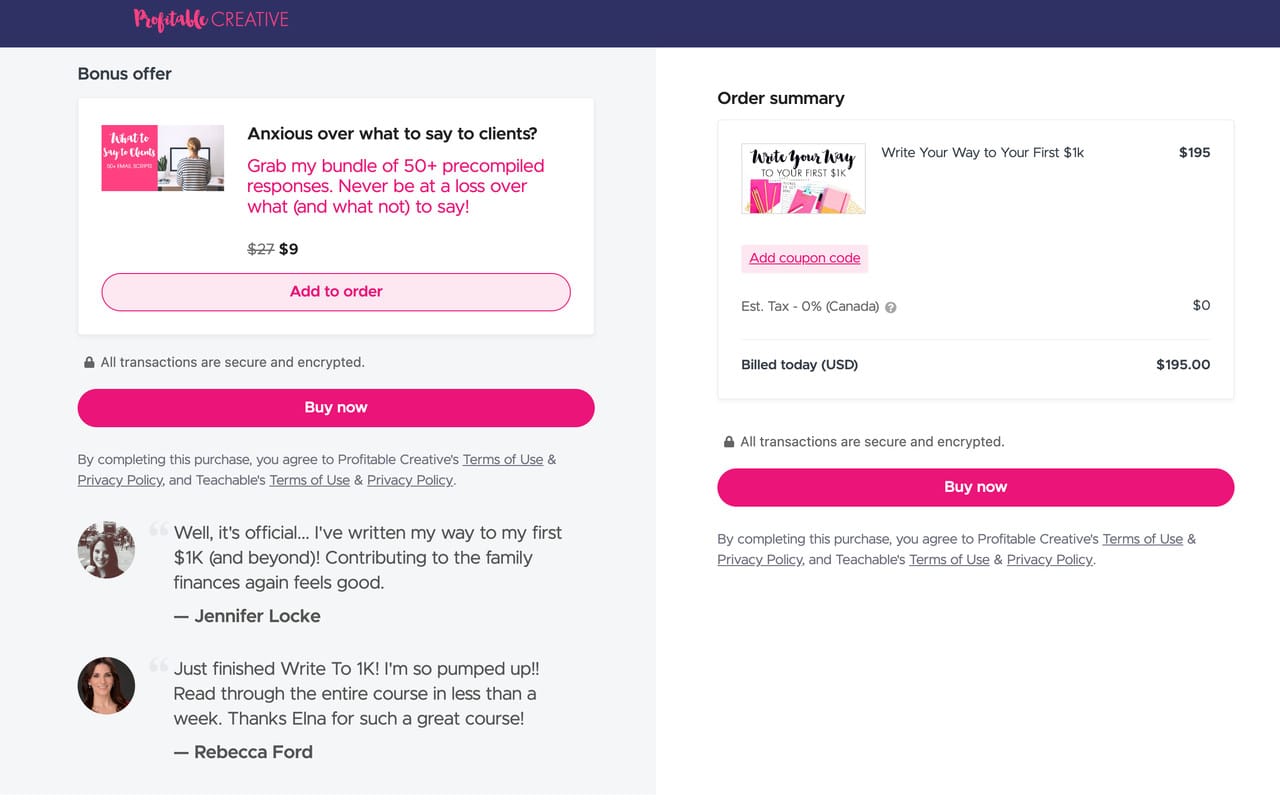
5. Pricing Plans
There are four pricing plans for Teachable: free, Basic plan, Pro plan and Pro+ plan. With the free plan, you can get a feel for whether this is the best course platform or not. Plus, it's one of the cheapest options among other course platforms.
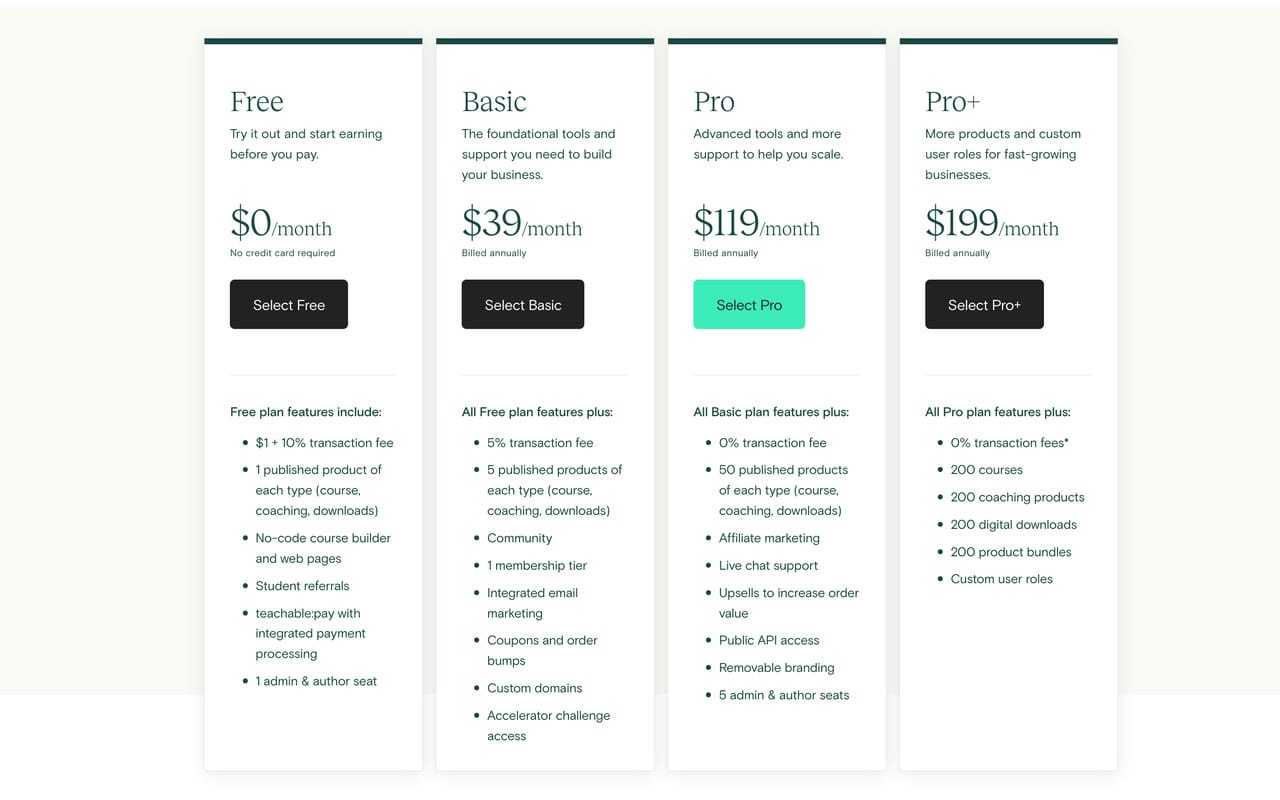
When comparing it to Thinkific pricing plans, both have a free plan and their basic pricing is similar to Thinkific at $36/month. In contrast, while Kajabi offers a free trial, their basic plans start at $119/month, making it the most expensive course platform available.
Teachable Cons
So, does Teachable have any shortcomings? There are a few that might make or break your decision to use Teachable for creating and hosting courses.
One possible disadvantage is the optional hefty BackOffice fees if you enable it. Teachable is the only course platform with these fees, but when you break it down, this makes your life as a course creator much easier.
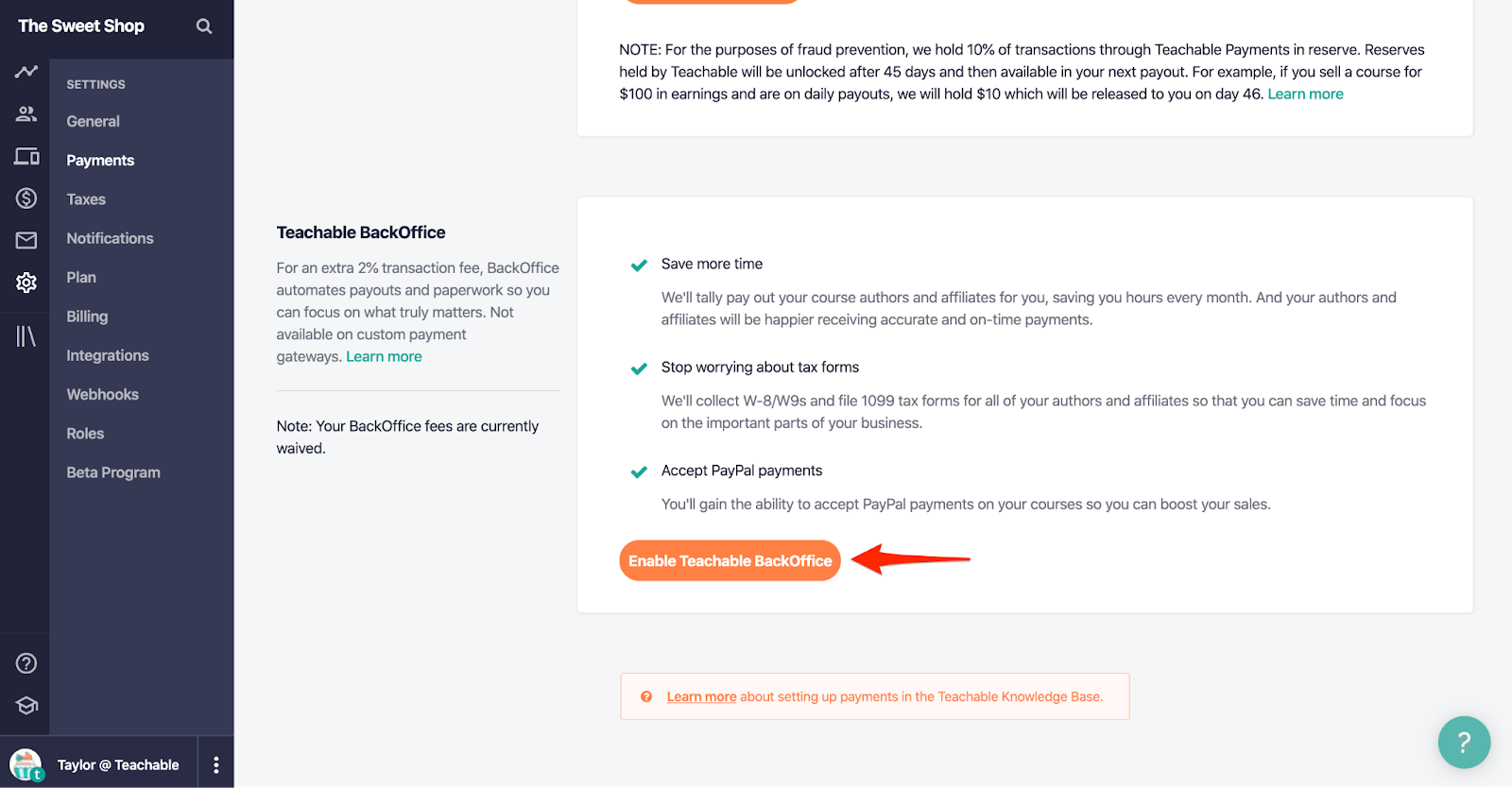
With this fee, Teachable becomes the merchant of record. This means they handle all the affiliate payouts and taxes. Other course platforms like Kajabi or Thinkific, don't have this option, so you're left with a third-party payment processor like Stripe or Paypal, leaving you to handle all the affiliate payouts and taxes that go with it.
But, this gets expensive for the course creator.
On top of the BackOffice fees of 2-2.8% per transaction, there are transaction fees (vary between paid plans of 1-10%) and processing fees charged by payment processors like credit cards.
You might be looking at upwards of $20 of fees per sale you incur.
Next, if you want to sell your app, Teachable isn't the course platform for you. You'll need the ThinkPartner account to build an app on Thinkific, or for Kajabi, upgrade to the Growth or Pro plan to access the Branded App add-on.
Now, if you want an all-in-one course platform, Teachable isn't it. They say they are the anti-all-in-one platform.
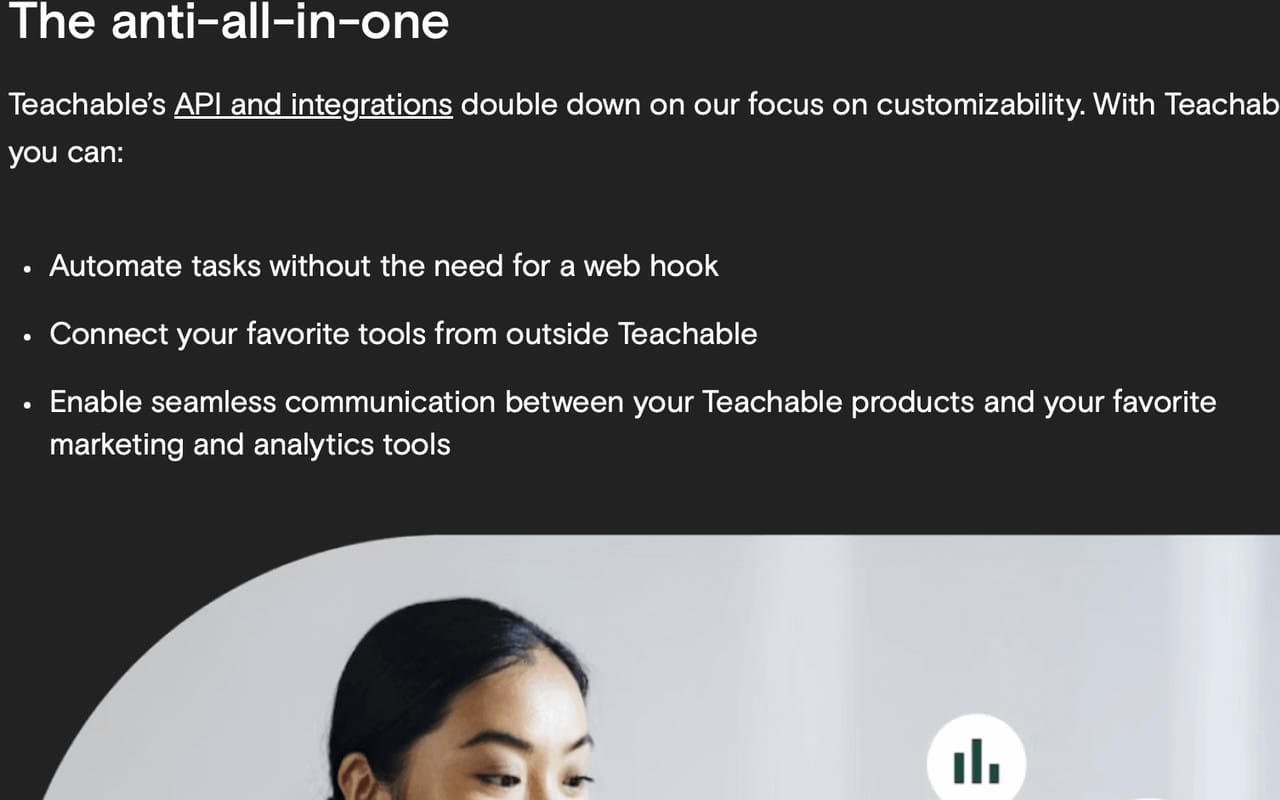
Teachable says you must rely on third-party integrations to have a full-functioning business. While I feel this could be an advantage since it's best to use a company that specializes in a certain feature (Zendesk for customer service, ClickFunnels for funnels, Discord for real-time discussions) rather than a jack-of-all-trades platform, you may not want to pay for all of those tools.
Kajabi and Thinkific are marketed as an all-in-one solution for creators with more advanced features like student reviews, sales page templates, and more website builder features.
Is Teachable the Right Platform for Your Online Course?
The bottom line is Teachable is a user-friendly platform perfect for creators and small businesses looking to create and sell online courses without needing coding skills. While it may lack some of the advanced features of all-in-one solutions like Kajabit or Thinkific, Teachable makes up for it with simplicity and a focus on course delivery. If you prioritize ease of use and straightforward course management, Teachable comes in strong. Overall, Teachable performs well as a course platform for those who want a balance between functionality and convenience.
However, if you are searching for an all-in-one platform for selling your online course, there is another excellent option for all digital creators - Whop.
The All-in-One Platform for Online Courses: Whop
One platform not yet mentioned in this platform review is Whop. Whop is an online marketplace for digital products, including SaaS products, paid community access, digital downloadables, eBooks, and online courses. Whop is an all-in-one platform that caters to all kinds of digital creators. Like Teachable, Whop offers everything you need to sell your online course, with a course builder, the ability to create membership tiers, and the sale of digital downloads.
Whop also comes with a powerful seller dashboard providing analytics support, where you can view statistics like revenue, customers, signups and top customers. The seller dashboard also offers options for affiliate marketing, a resolution center to keep your customers happy, and even the ability to easily create apps for your course customers and offer up unique experiences! Plus, with Whop, you are always supported - Whop's customer support has a 97% satisfaction rate and an average 3-minute response time.
When compared to Teachable, here are some of the advantages of selling your course with Whop:
- Low fees: The transaction fee on Whop is just 3%.
- More variety: You can sell web apps, SaaS products, community access, digital content, and courses. So, as a course creator, you can offer up all kinds of different products to your customer base, branching out into new markets and monetizing new ideas.
- Responsive customer service: Whop gives you the help you need, when you need it. You do not have to wait for an email reply, and customer contact hours are not based on your membership level. Whop's customer service is available 24/7, 365 days a year.
- Increased discoverability: The Whop marketplace has already processed more than $250,000,000 in sales, and has a steady stream of traffic from consumers eager to buy your content.
Sell Your Online Course with Whop!
The Whop marketplace has already processed more than $250,000,000 in sales. There is a growing stream of traffic from consumers eager to buy your course! So, why not give Whop a try?
This all-in-one platform is a great option for all course creators - and signing up is completely free. Sell your course with Whop!
